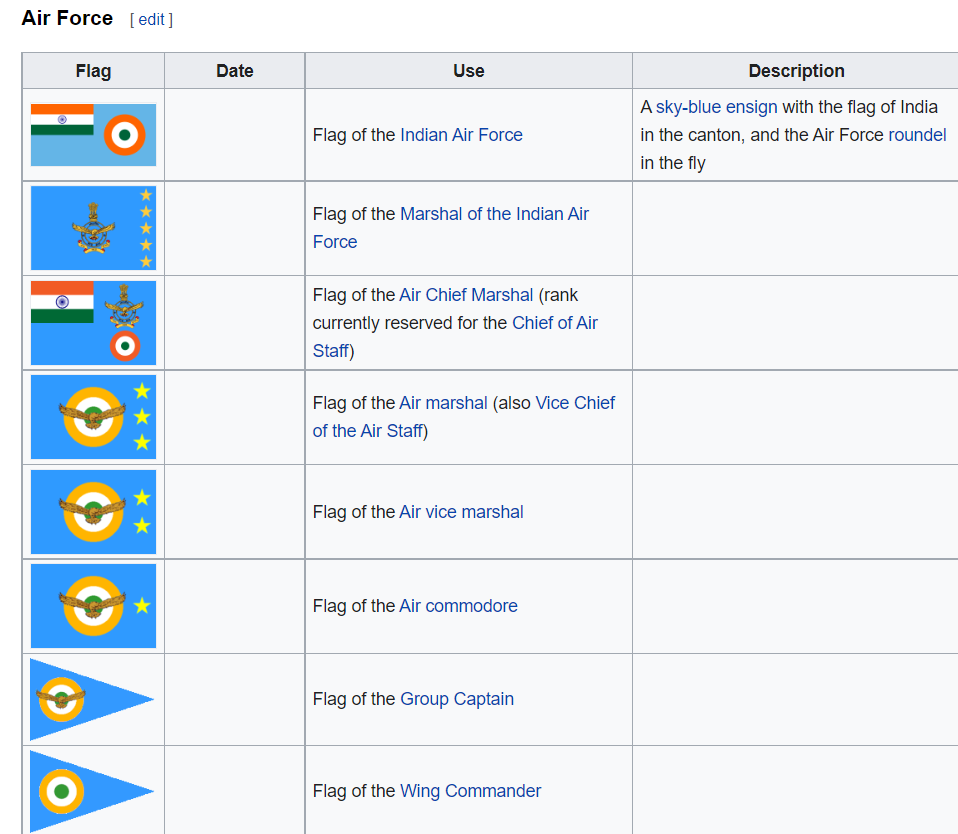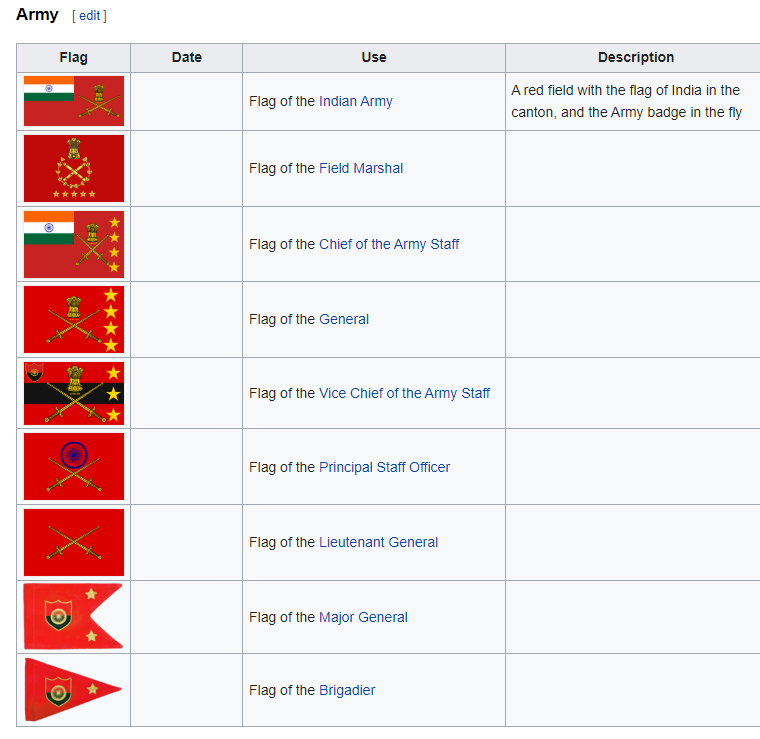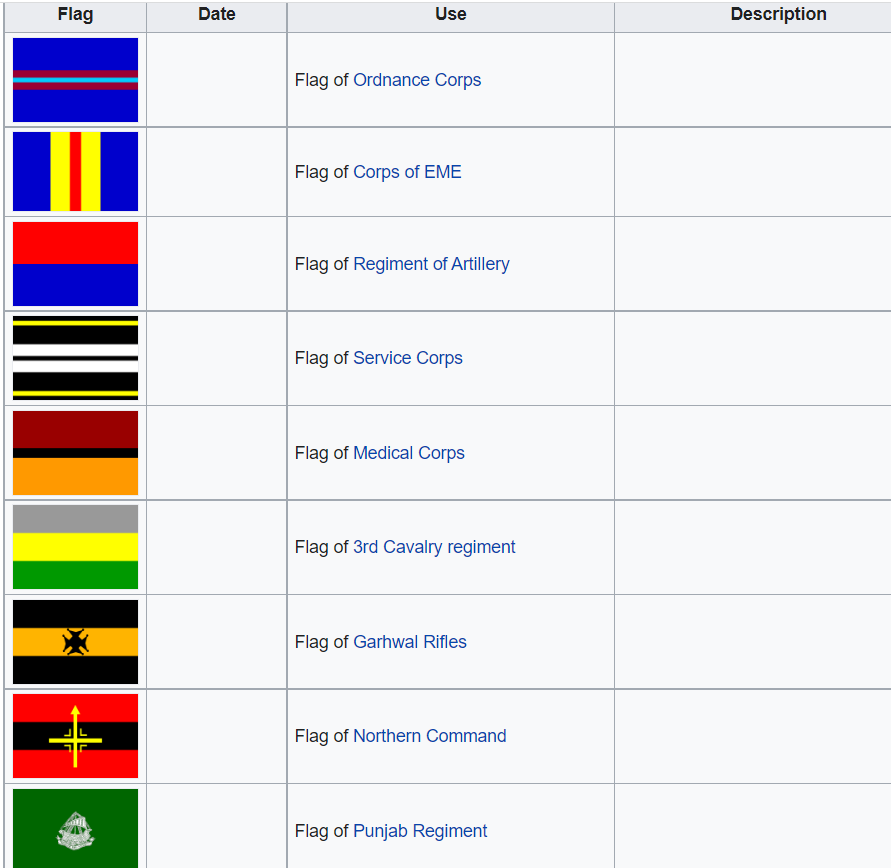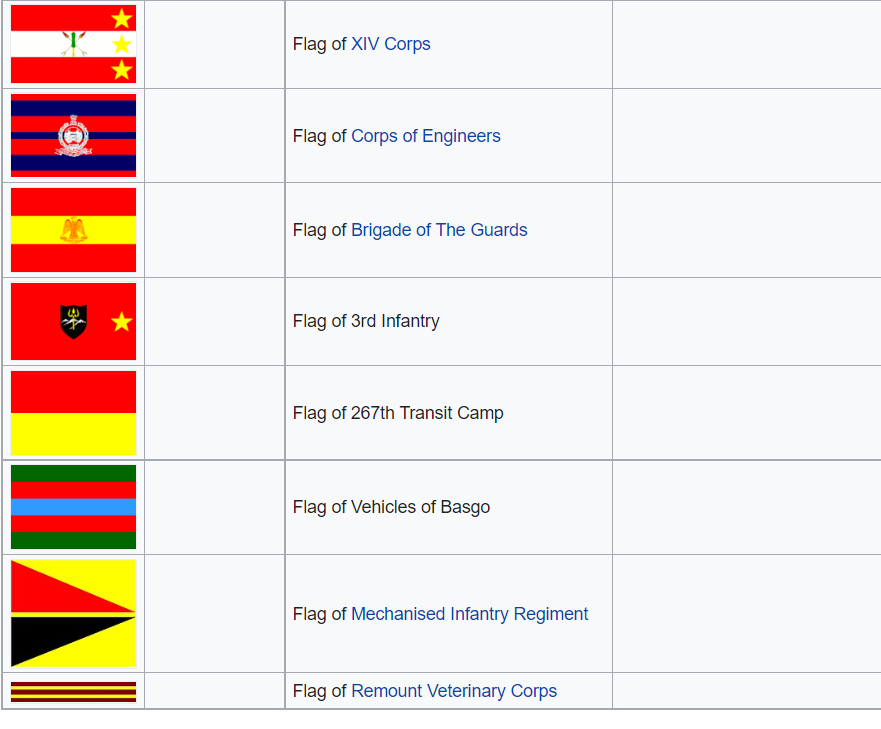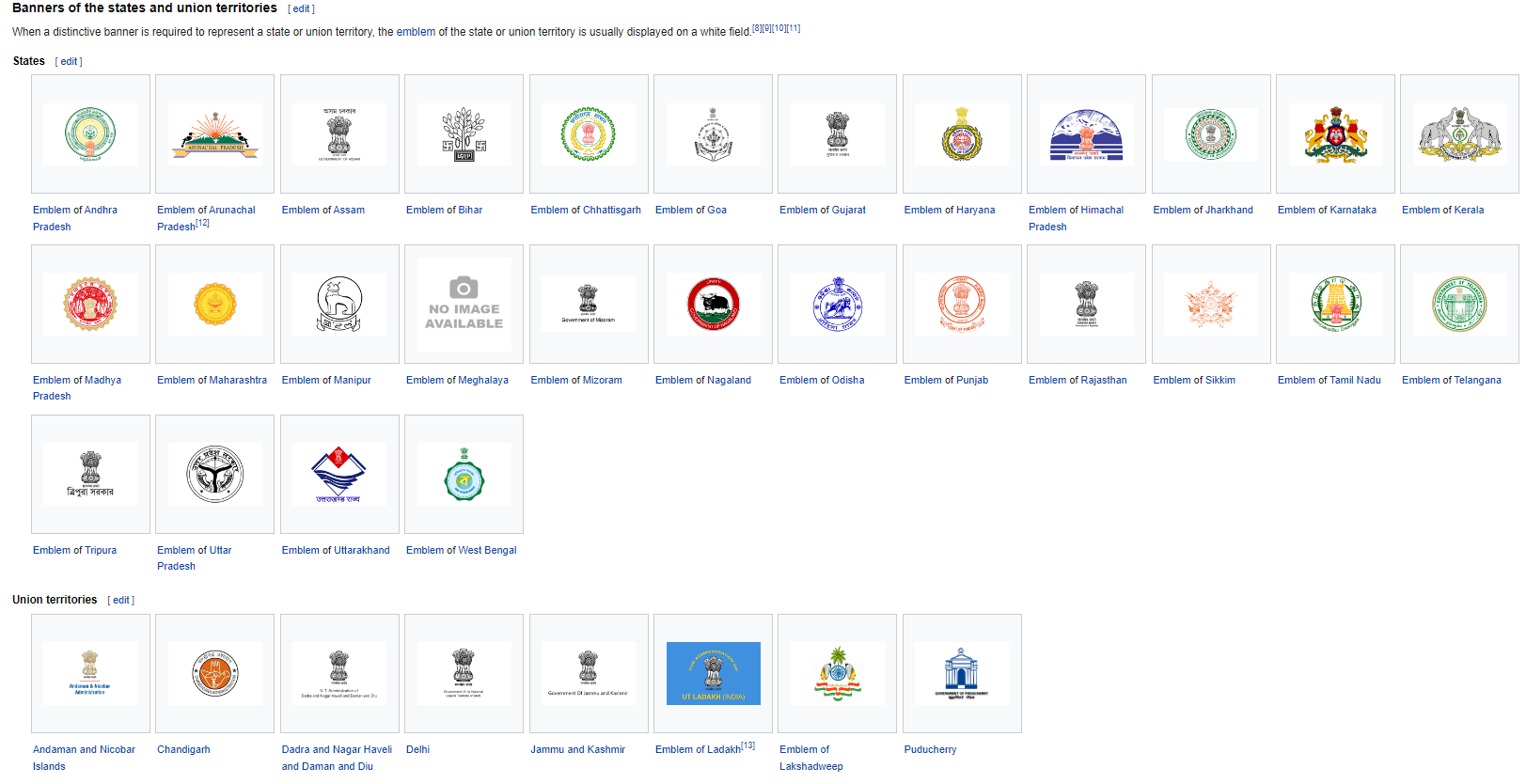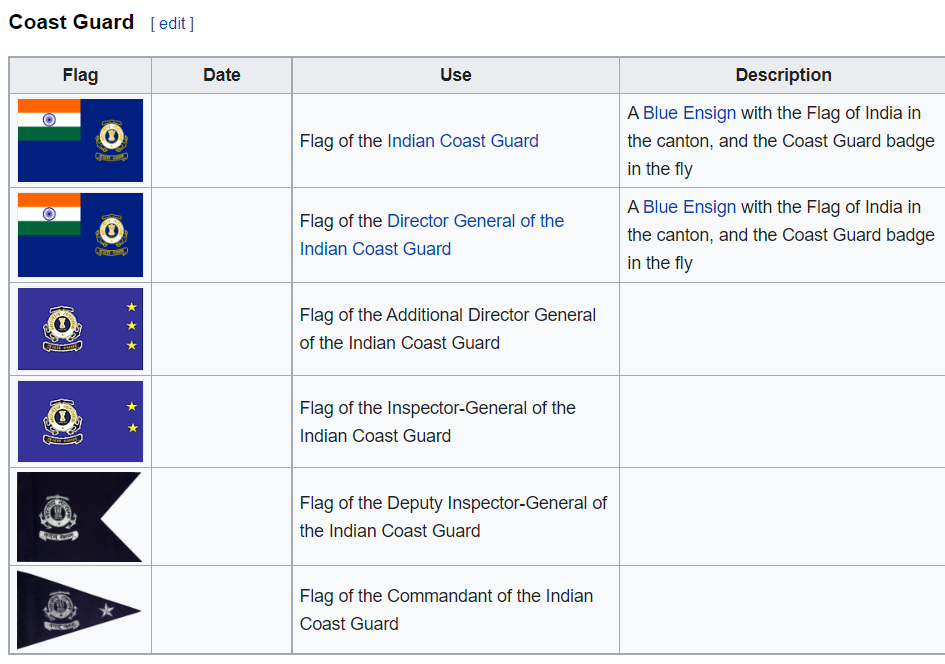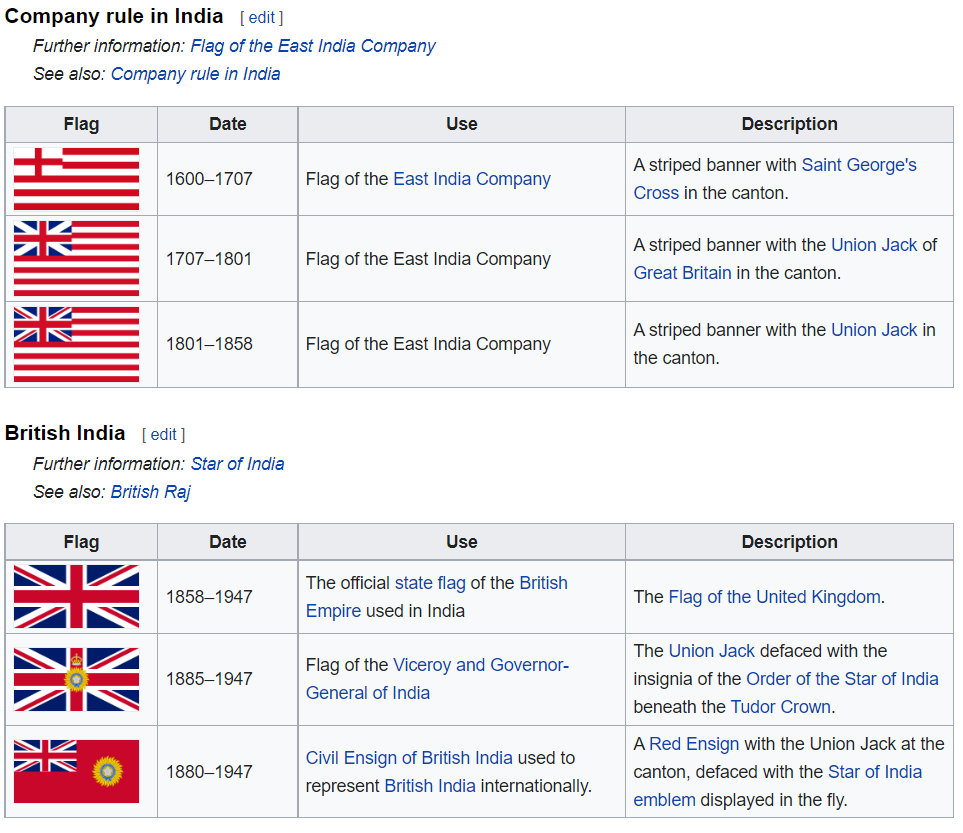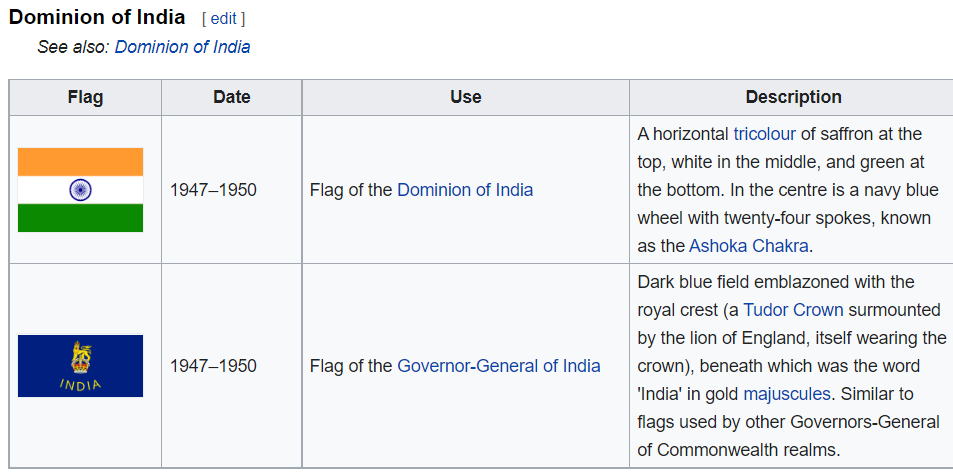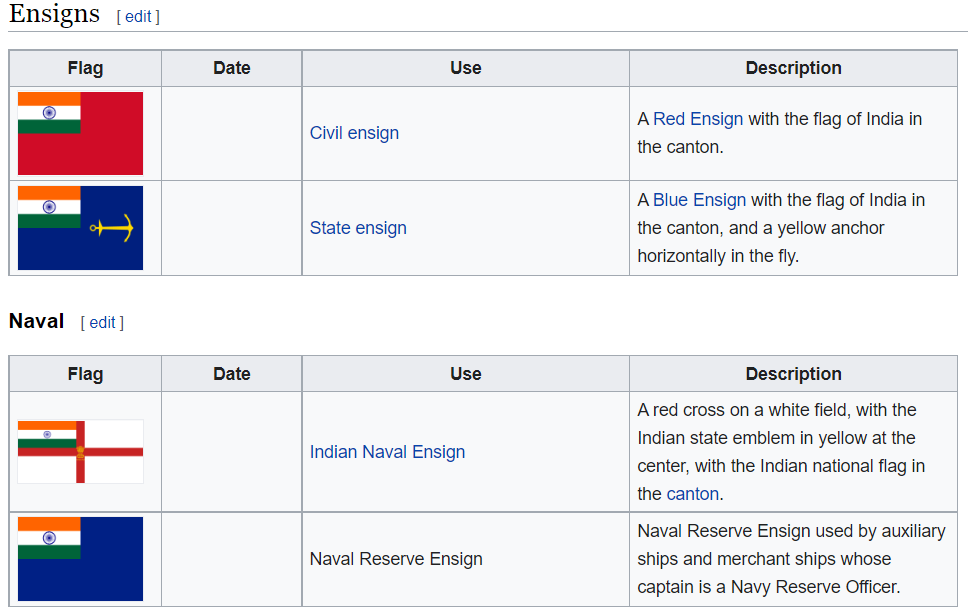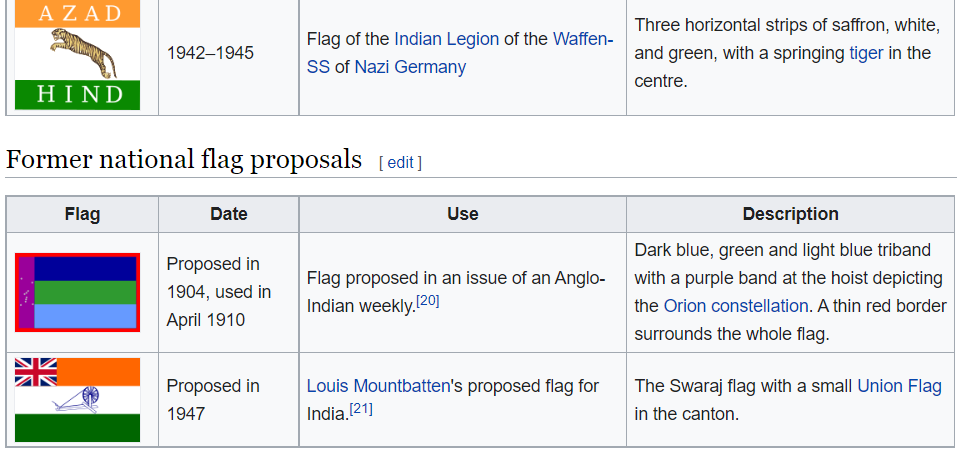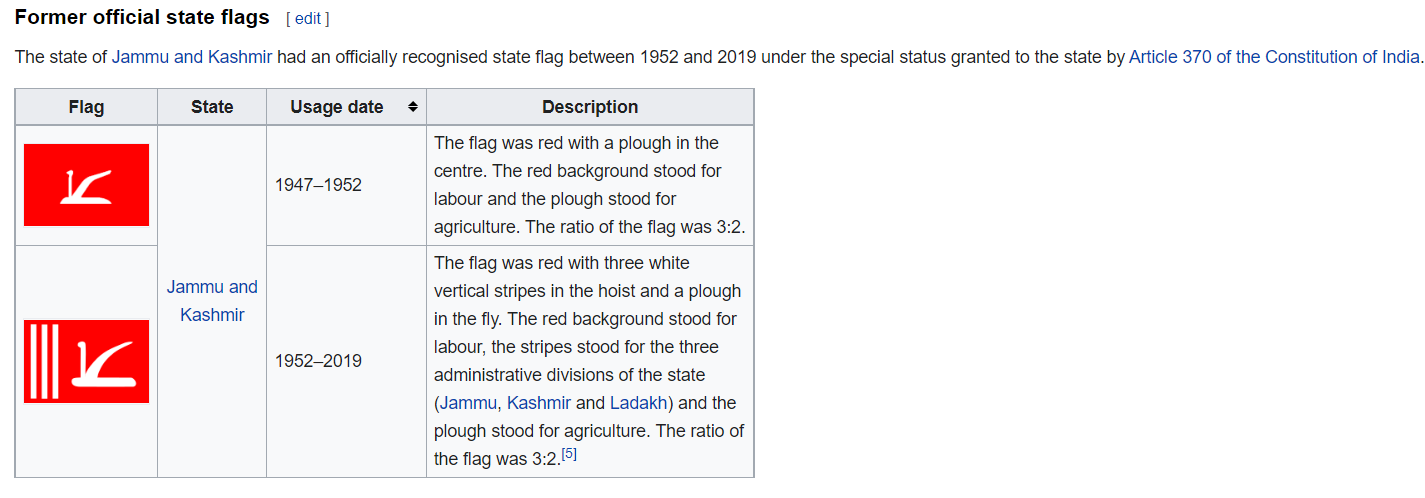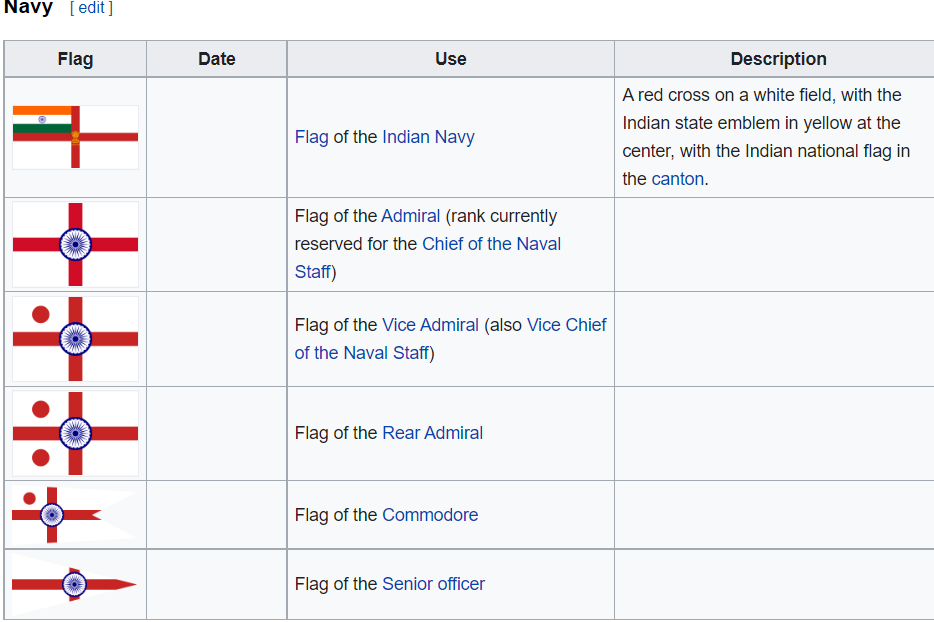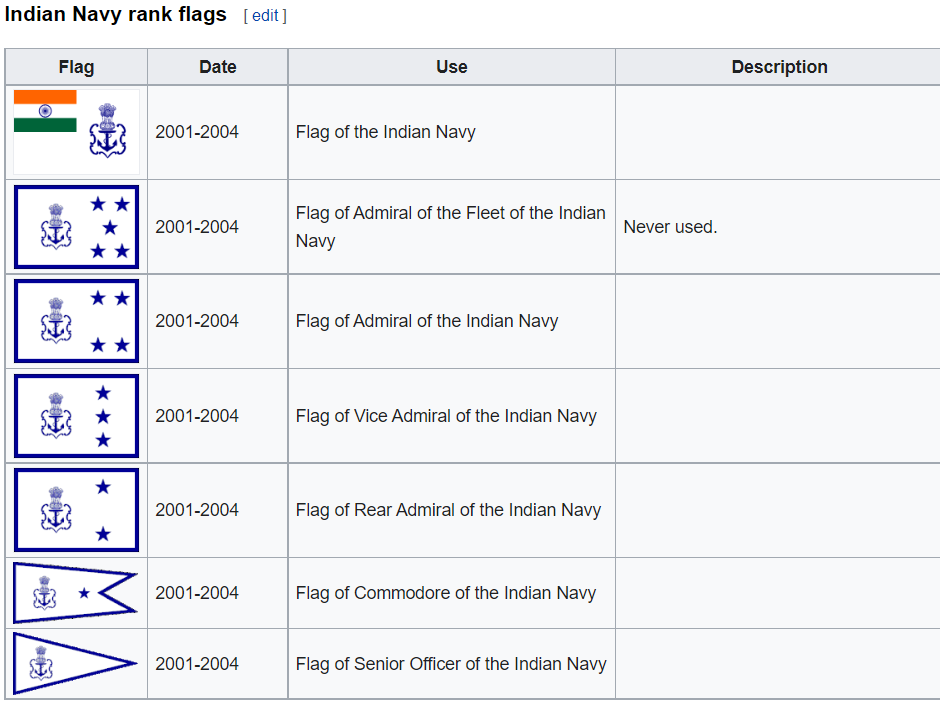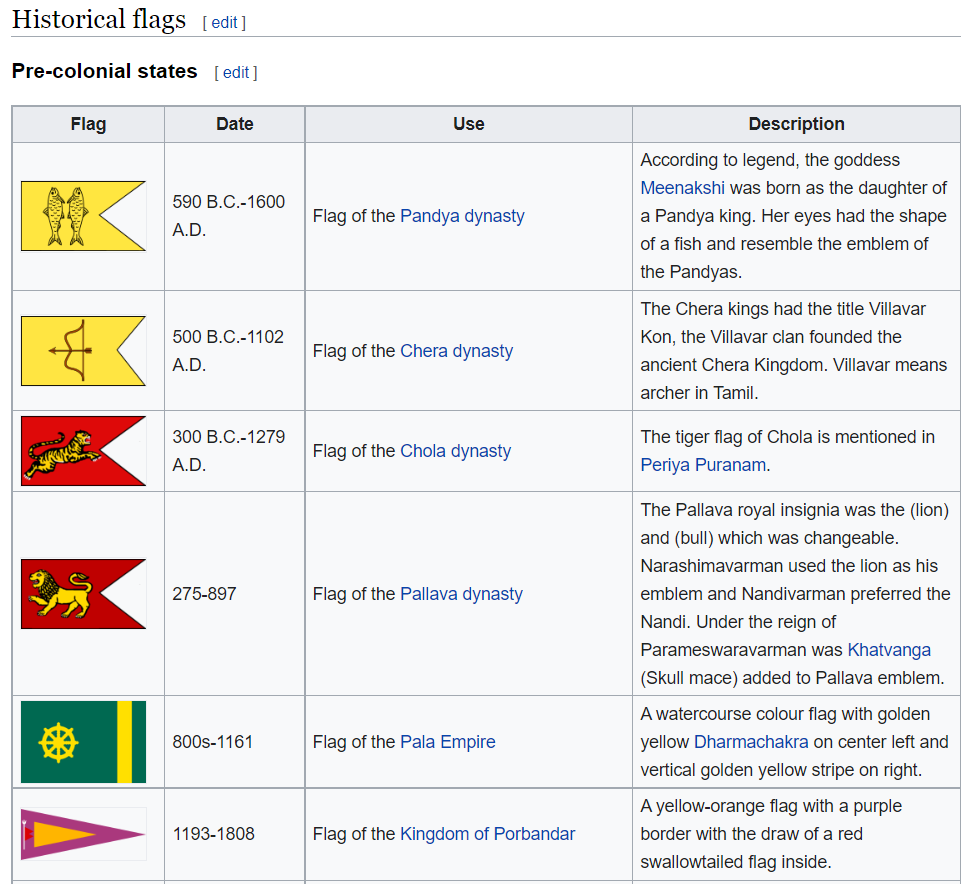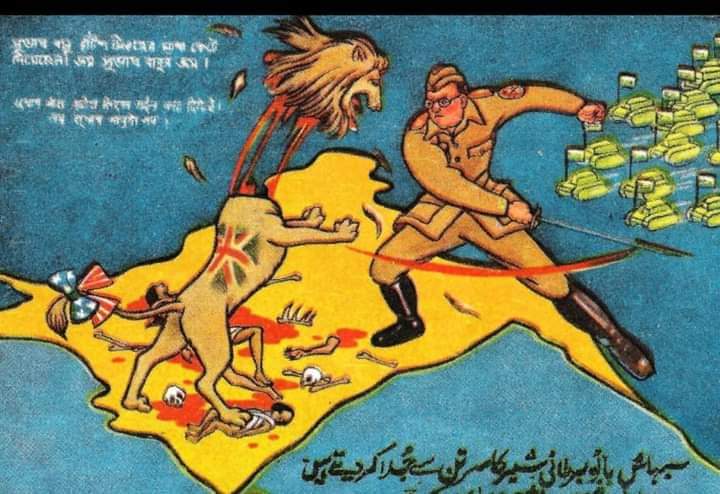What is the full name of India-- The Republic of India or Bharat Ganrajya.
जानिए स्वतंत्रता दिवस और गणतंत्र दिवस में झंडा फहराने में क्या है अंतर ?
पहला अंतर
15 अगस्त स्वतंत्रता दिवस के अवसर पर झंडे को नीचे से रस्सी द्वारा खींच कर ऊपर ले जाया जाता है, फिर खोल कर फहराया जाता है, जिसे *ध्वजारोहण कहा जाता है क्योंकि यह 15 अगस्त 1947 की ऐतिहासिक घटना को सम्मान देने हेतु किया जाता है जब प्रधानमंत्री जी ने ऐसा किया था। संविधान में इसे अंग्रेजी में Flag Hoisting (ध्वजारोहण) कहा जाता है।
जबकि
26 जनवरी गणतंत्र दिवस के अवसर पर झंडा ऊपर ही बंधा रहता है, जिसे खोल कर फहराया जाता है, संविधान में इसे Flag Unfurling (झंडा फहराना) कहा जाता है।
--–----------------------------------
दूसरा अंतर
15 अगस्त के दिन प्रधानमंत्री जो कि केंद्र सरकार के प्रमुख होते हैं वो ध्वजारोहण करते हैं, क्योंकि स्वतंत्रता के दिन भारत का संविधान लागू नहीं हुआ था और राष्ट्रपति जो कि राष्ट्र के संवैधानिक प्रमुख होते है, उन्होंने पदभार ग्रहण नहीं किया था। इस दिन शाम को राष्ट्रपति अपना सन्देश राष्ट्र के नाम देते हैं।
जबकि
26 जनवरी जो कि देश में संविधान लागू होने के उपलक्ष्य में मनाया जाता है, इस दिन संवैधानिक प्रमुख राष्ट्रपति झंडा फहराते हैं
-----------------------–--------------
तीसरा अंतर
स्वतंत्रता दिवस के दिन लाल किले से ध्वजारोहण किया जाता है।
जबकि
गणतंत्र दिवस के दिन राजपथ पर झंडा फहराया जाता है
on 26thJanuary the national flag is UNFURLED, while on 15thAugust it is HOISTED.
The logic behind this is that on 15th August the flag is tied to the bottom of the pole, it is lifted up to the top and then hoisted.
To symbolise the struggle for independence while lifting it up the pole and then celebrating independence by hoisting it.
While on 26th January India became an independent republic!
On the top now , free from the clutches of years of foreign occupation !
Thus the flag is tied to the top of the pole and not at the bottom as on 15th August.
Hence the Flag is UNFURLED!
(Hoist meaning to pull something up with a rope)
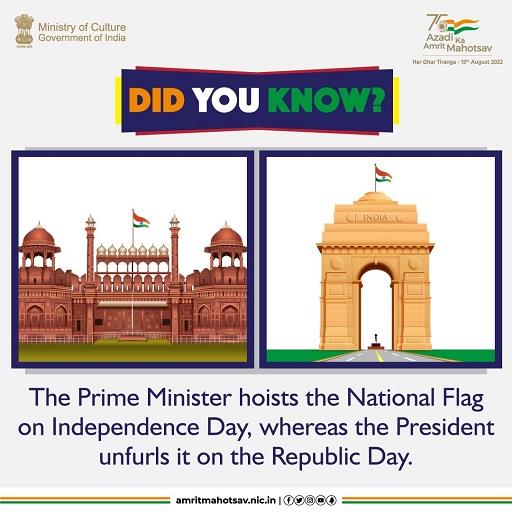
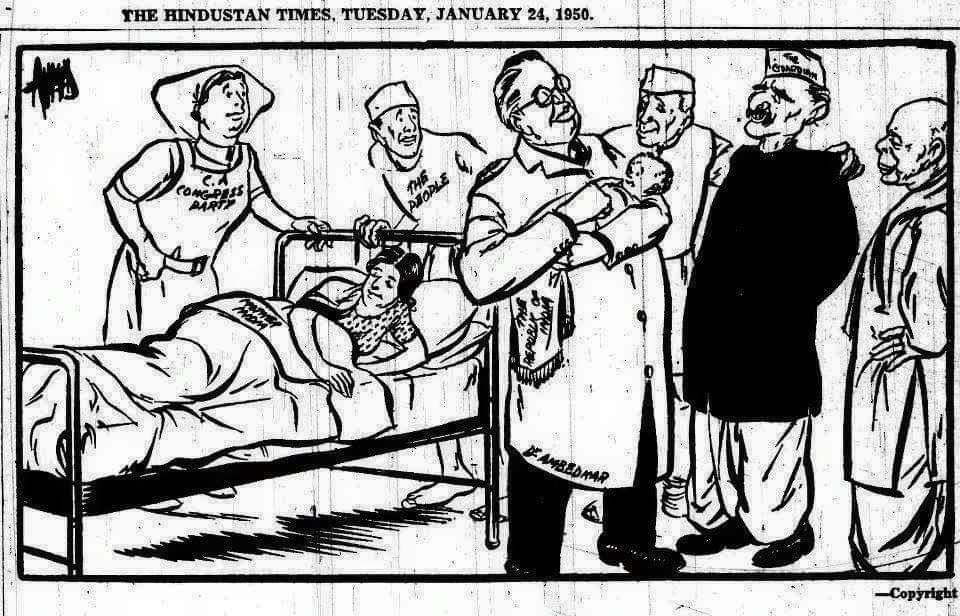
This Cartoon, which was published in the year 1950, on 24th January, that is two days before the first Indian Republic day, in The Hindustan Times, drawn by the famous Cartoonist Enver Ahmed . Cartoon showing Mother India giving birth to a baby called The Republic of India and DOCTOR Ambedkar holding that baby in his hands and giving a gentle touch, while the other characters in the background (from Left to Right ) Constituent Assembly congress Party as Nurse, t he people, Jawaharlal Nehru , Babu Rajendra Prasad and Vallabhai Patel all of them are looking at the newly born baby with great anxiety
The Constitution of India was written by hand. No instrument was used to write the whole constitution. Prem Bihari Narayan Raizada, a resident of Delhi, wrote this huge book, the entire constitution, in italic style with his own hands.
Prem Bihari was a famous calligraphy writer of that time. He was born on 16 December 1901 in the family of a renowned handwriting researcher in Delhi. He lost his parents at a young age. He became a man to his grandfather Ram Prasad Saxena and uncle Chatur Bihari Narayan Saxena. His grandfather Ram Prasad was a calligrapher. He was a scholar of Persian and English. He taught Persian to high-ranking officials of the English government.
Dadu used to teach calligraphy art to Prem Bihari from an early age for beautiful handwriting. After graduating from St. Stephen's College, Delhi, Prem Bihari started practicing calligraphy art learned from his grandfather. Gradually his name began to spread side by side for the beautiful handwriting. When the constitution was ready for printing, the then Prime Minister of India Jawaharlal Nehru summoned Prem Bihari. Nehru wanted to write the constitution in handwritten calligraphy in italic letters instead of in print.
That is why he called Prem Bihari. After Prem Bihari approached him, Nehruji asked him to handwrite the constitution in italic style and asked him what fee he would take.
Prem Bihari told Nehruji “Not a single penny. By the grace of God I have all the things and I am quite happy with my life. ” After saying this, he made a request to Nehruji "I have one reservation - that on every page of constitution I will write my name and on the last page I will write my name along with my grandfather's name." Nehruji accepted his request. He was given a house to write this constitution. Sitting there, Premji wrote the manuscript of the entire constitution.
Before starting writing, Prem Bihari Narayan came to Santiniketan on 29 November 1949 with the then President of India, Shri Rajendra Prasad, at the behest of Nehruji. They discussed with the famous painter Nandalal Basu and decided how and with what part of the leaf Prem Bihari would write, Nandalal Basu would decorate the rest of the blank part of the leaf.
Nandalal Bose and some of his students from Santiniketan filled these gaps with impeccable imagery. Mohenjo-daro seals, Ramayana, Mahabharata, Life of Gautam Buddha, Promotion of Buddhism by Emperor Ashoka, Meeting of Vikramaditya, Emperor Akbar and Mughal Empire.
Prem Bihari needed 432 pen holders to write the Indian constitution and he used nib number 303. The nibs were brought from England and Czechoslovakia. He wrote the manuscript of the entire constitution for six long months in a room in the Constitution Hall of India. 251 pages of parchment paper had to be used to write the constitution. The weight of the constitution is 3 kg 650 grams. The constitution is 22 inches long and 16 inches wide.
Prem Bihari died on February 17, 1986.
The Indian National Flag represents the hopes and aspirations of the people of India. It is the symbol of our national pride. Over the last five decades, several people including members of armed forces have ungrudgingly laid down their lives to keep the tricolour flying in its full glory.
Flags had equal importance in ancient India, being carried on chariots and elephants. The flag was the first object of attack in battle, and its fall would mean confusion if not defeat. Indian flags were often triangular in shape and scarlet or green in colour, with a figure embroidered in gold and a gold fringe. If those and the Chinese flags had a common origin in the standards of ancient Egypt and Assyria (standards, in that sense, meaning solid objects, such as metal animals, attached atop poles), then they might have developed from the streamers often attached to the pole. That possibility gains some likelihood from the fact that some Indian flagstaffs were surmounted by a figure similar to that displayed on the flag itself. Mughal royal insignia included, however, other things besides the flag, more especially yaks’ tails and the state umbrella. Flags seem also to have been used, in India as in China, for signaling, and there is an instance of a white flag being used as a signal for a truce as early as 1542 CE. Indian and Chinese usage spread to Myanmar (Burma), Siam (now Thailand), and other parts of southeastern Asia. Flags with a background of white, yellow, or black silk are mentioned, with devices (an elephant, a bull, or a water hen, for example) embroidered on them in gold. A Siamese treatise on war gives the impression that the flags were unfurled as the march began.
For decades the All-India Congress under the leadership of Mohandas K. Gandhi struggled to rally the millions of British-ruled peoples in the Indian subcontinent. Like similar movements in other countries, it early felt the need for a distinctive symbol that could represent its nationalist objectives. In 1921 a university lecturer named Pingali (or Pinglay) Venkayya presented a flag design to Gandhi that consisted of the colours associated with the two principal religions, red for the Hindus and green for the Muslims. To the centre of the horizontally divided flag, Lala Hans Raj Sondhi suggested the addition of the traditional spinning wheel, which was associated with Gandhi’s crusade to make Indians self-reliant by fabricating their own clothing from local fibres.
Gandhi modified the flag by adding a white stripe in the centre for the other religious communities in India, thus also providing a clearly visible background for the spinning wheel. In May 1923 at Nagpur, during peaceful protests against British rule, the flag was carried by thousands of people, hundreds of whom were arrested. The Congress flag came to be associated with nationhood for India, and it was officially recognized at the annual meeting of the party in August 1931. At the same time, the current arrangement of stripes and the use of deep saffron instead of red were approved.
To avoid the sectarian associations of the original proposal, new attributions were associated with the saffron, white, and green stripes. They were said to stand for, respectively, courage and sacrifice, peace and truth, and faith and chivalry. During World War II Subhas Chandra Bose used this flag (without the spinning wheel) in territories his Japanese-aided army had captured.
-
Writing in his journal, Young India, Mahatma Gandhi first spoke about the need for an Indian flag in 1921. He proposed a flag with the charkha or spinning wheel at the centre.
-
The idea of the spinning wheel was put forth by Lala Hansraj, and Gandhi commissioned Pingali Venkayya to design a flag on a red and green banner. The flag underwent some changes and became the official flag of the Congress at the 1931 meeting.
-
Pingali Venkayya (2 August 1876/8 – 4 July 1963) was an Indian freedom fighter and a Gandhian. He was the designer of the flag on which the Indian National Flag was based.
After the war Britain agreed to consider freedom for India, although the country was divided and a Muslim-dominated Pakistan was given separate statehood. On July 22, 1947, the Indian national flag was officially hoisted. Its stripes remained the same saffron-white-green, but the spinning wheel was replaced by a blue chakra—the Dharma Chakra (“Wheel of the Law”). The Dharma Chakra, which was associated with the emperor Ashoka in the 3rd century BCE, appeared on pillars erected throughout the Mauryan empire during the first serious attempt to unite all of India under a single government. The 1947 flag continues to be used by India, although special versions have been developed for ships registered in the country.
Flag- a piece of cloth, bunting, or similar material displaying the insignia of a sovereign state, a community, an organization, an armed force, an office, or an individual. A flag is usually, but not always, oblong and is attached by one edge to a staff or halyard.
Flag Parts-
The part nearest the staff is called the hoist, and the outer part is called the fly. A flag’s length (also called the fly) usually exceeds its width (hoist). The main portion of the flag, constituting all or most of its area, is called the field or ground. In addition, flags often have a design element in the upper corner of the hoist, called the canton, which is distinct from the field. Flags of various forms and purpose are known as colours, standards, banners, ensigns, pendants (or pennants), pennons, guidons, and burgees.
Flags originally were used mainly in warfare, and to some extent they have remained insignia of leadership, serving for the identification of friend or foe and as rallying points. They are now also extensively employed for signaling, for decoration, and for display. Because the usefulness of a flag for purposes of identification depends on its blowing out freely in the wind, the material that is preferred is usually light and bears a device or pattern identical on both sides. Wording therefore tends to be excluded, and the simpler patterns are favoured. Any colours or devices may be used, but European usage normally follows the practice of heraldry in discouraging the juxtaposition of “metal” and “metal” (i.e., of yellow and white) or of colour and colour without “metal” interposed. The flag of the Vatican city-state constitutes an exception to that rule.
National flags are one of the symbols of a country. Evolved from ship flags in the early 17th century. There are three subtypes of the national flags: state flag, which can be flown only by government agencies; civil flag, which can be used by anyone and war flag that is used by military organizations.
International flags are flags that symbolize union of any type between nations.
Maritime flags are the flags used at sea. There are national flags (so called ensigns) and they can be state ensigns that are used by government ships, civil ensigns that are flown by private vessels and war ensigns used by naval vessels. They show country of origin of the vessel. At the sea are also used signaling flags for conveying messages. They can spell words letter by letter, they can be combined to convey more complex message or they can each carry one complex message. House flags show which company owns the ship. Yacht club burgee identify to which yacht club yacht belongs. Courtesy flag is a flag of a country through which waters the ship is sailing. Pennants cans mark commissioning of the ship, starting of a religious service on the vessel, presence of senior officer on the vessel or a time for drinks on a ship.
Sport flags are used in sports as a method of signalization. They are used in football for signaling potential breaking of the rules, in racing (auto, motorcycle and yacht) to signal start and end of the race , disqualifications or warnings of obstacles on the race track, in golf to mark holes, in diving to indicate locations of underwater scuba divers, in “capture the flag” and many other sports.
Political flags can represent political parties. Some national flags are or were evolved from political flags of parties that came to power.
Swimming flags are used to mark the limits of the bathing area on a beach. They are diagonaly divided into two parts: red (bottom left part) and yellow (upper right part).
Railway flags are used on the railroads for signalization.
Semaphore flags are also used for signalization. They are used by signalmen at sea or on land, who use two flags (one in each hand) in spell words by changing position of flags.
Various flags had been used by members of the Indian independence movement prior to the independence being achieved in 1947. Pingali Venkayya designed the National Flag and presented it to Mahatma Gandhi during the latter’s visit to Vijayawada city on 1 April 1921. Venkayya’s first draft of the flag was in red and green — the red representing Hindus and green the Muslims living in the country. On Gandhi’s suggestion, Venkayya added a white stripe to represent all other denominations and religions present in India.Since 1921, Venkayya's flag has been used informally at all Congress meetings. The flag was adopted in its present form during a meeting of the Constituent Assembly on July 22, 1947.
On August 7, 1906, India hoisted the first National Flag of India in Calcutta (now Kolkata).
In the year of 1907, Bhikaji Cama hoisted the second flag in Paris.
During the Home Rule movement, Dr Annie Besant and Lokmanya Tilak hoisted the third flag in 1917.
In 1921, a man from Andhra Pradesh presented a flag to Mahatma Gandhi, which included a suggestion of white strip and Charkha. This incident took place during the session of the All India Congress Committee. This particular flag was made up of red and green colours.
In 1931, a resolution was passed to adopt a tricolour flag as our national flag. On August 31 of the same year Indian National Congress hoisted the flag and was formally adopted
From 1947 till now we have the tricolour flag of India. The flag was first hoisted at the Council House on August 15, 1947.
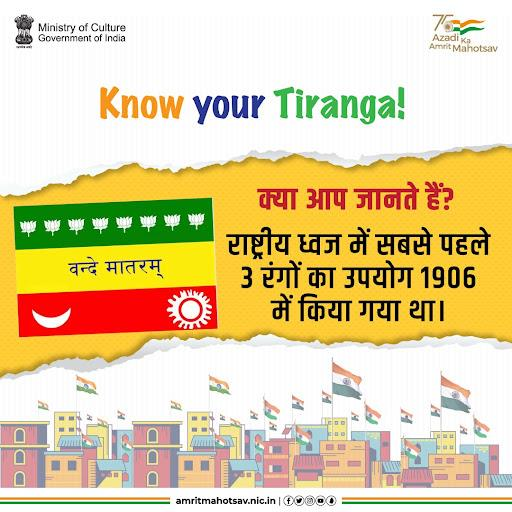
Unofficial flag of India in 1906
The first national flag in India is said to have been hoisted on August 7, 1906, in the Parsee Bagan Square (Green Park) in Calcutta now Kolkata.
The flag was composed of three horizontal strips of red, yellow and green.
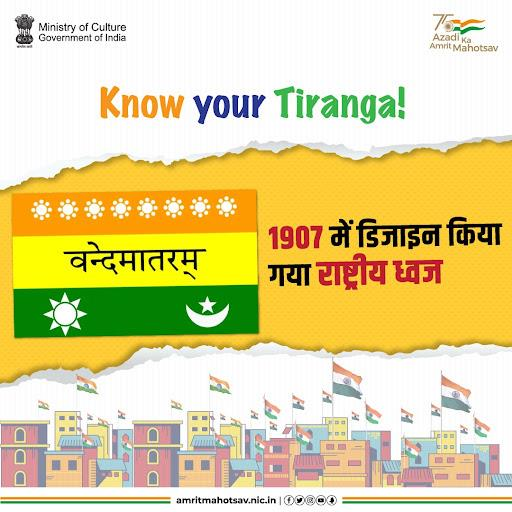
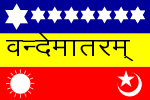
Berlin committee flag, 1907
The Berlin committee flag was first raised by Bhikaiji Cama in 1907. The second unofficial flag of India was hoisted in Paris by Madame Cama and her band of exiled revolutionaries in 1907.
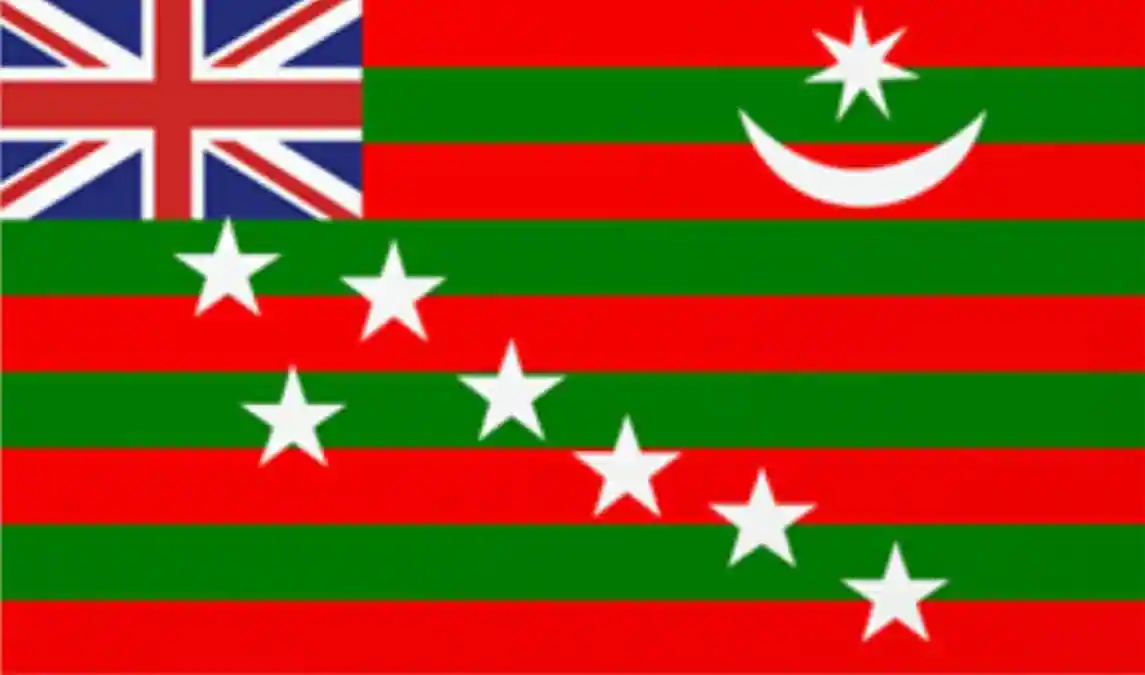
Flag used during Home Rule movement in 1917
The third flag went up in 1917 when our political struggle had taken a definite turn. Dr. Annie Besant and Lokmanya Tilak hoisted it during the Home rule movement. This flag had five red and four green horizontal strips arranged alternately, with seven stars in the saptarishi configuration super-imposed on them.
In the left-hand top corner (the pole end) was the Union Jack. There was also a white crescent and star in one corner.
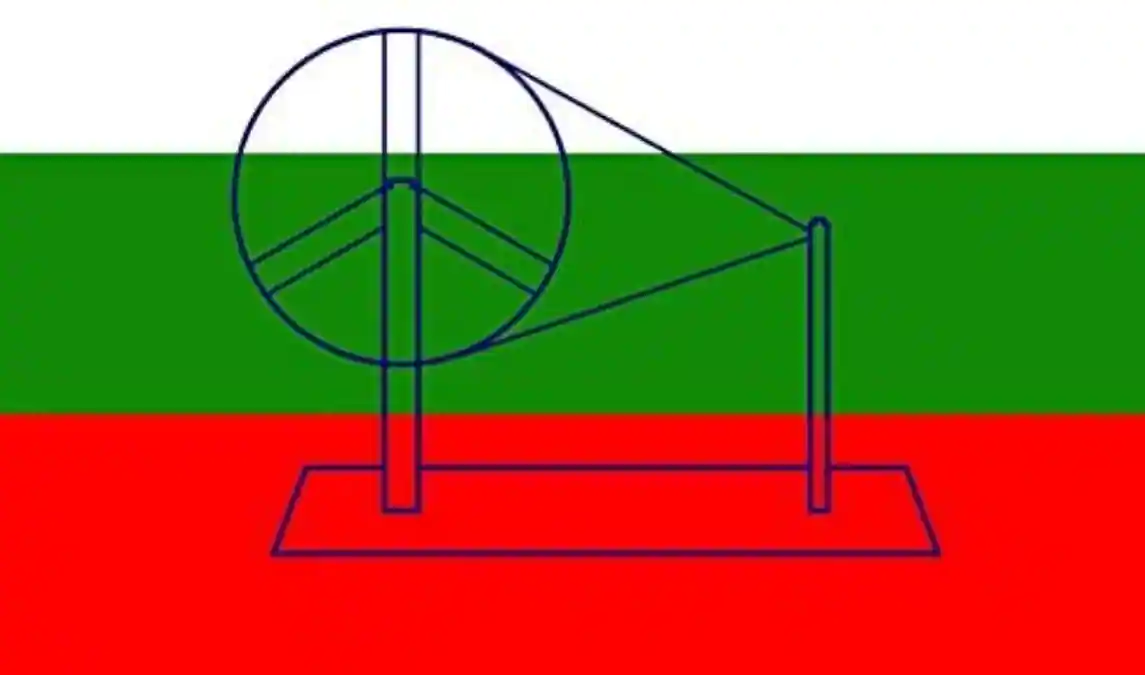
Flag unofficially adopted in 1921
During the session of the All India Congress Committee which met at Bezwada in 1921 (now Vijayawada) an Andhra youth prepared a flag and took it to Gandhiji. It was made up of two colours-red and green-representing the two major communities i.e. Hindus and Muslims. Gandhiji suggested the addition of a white strip to represent the remaining communities of India and the spinning wheel to symbolise progress of the Nation.
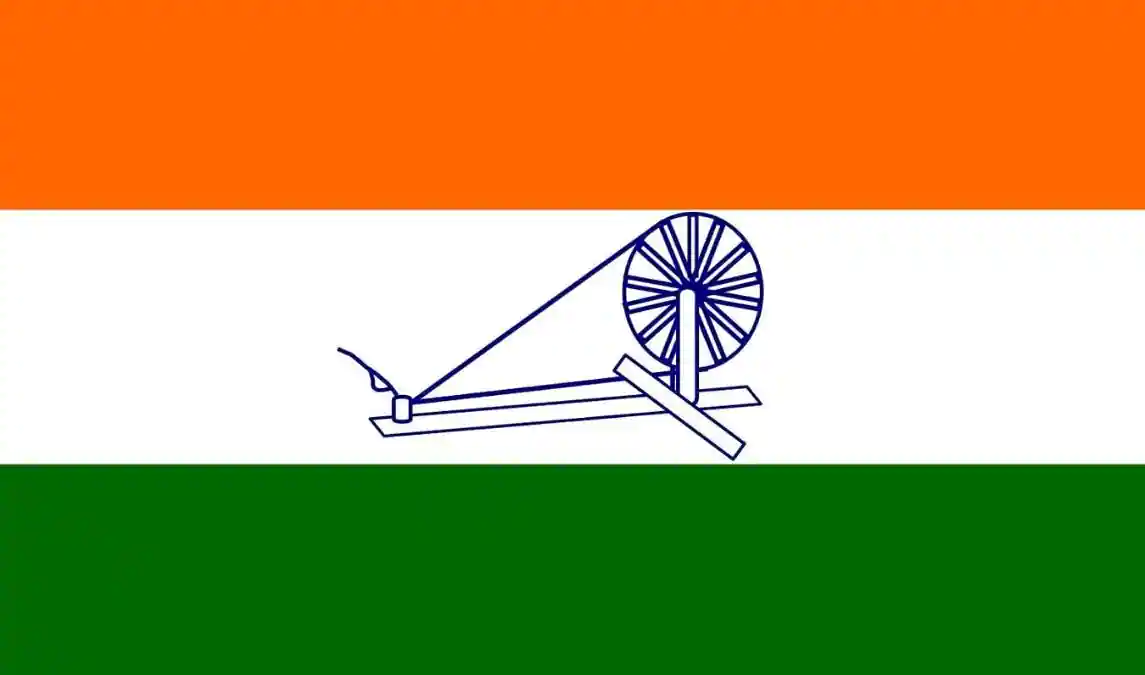
Flag adopted in 1931
This flag was also the battle ensign of the Indian National Army. The year 1931 was a landmark in the history of the flag. A resolution was passed adopting a tricolor flag as our national flag. This flag, the forbear of the present one, was saffron, white and green with Mahatma Gandhi's spinning wheel at the center. It was, however, clearly stated that it bore no communal significance and was to be interpreted thus.
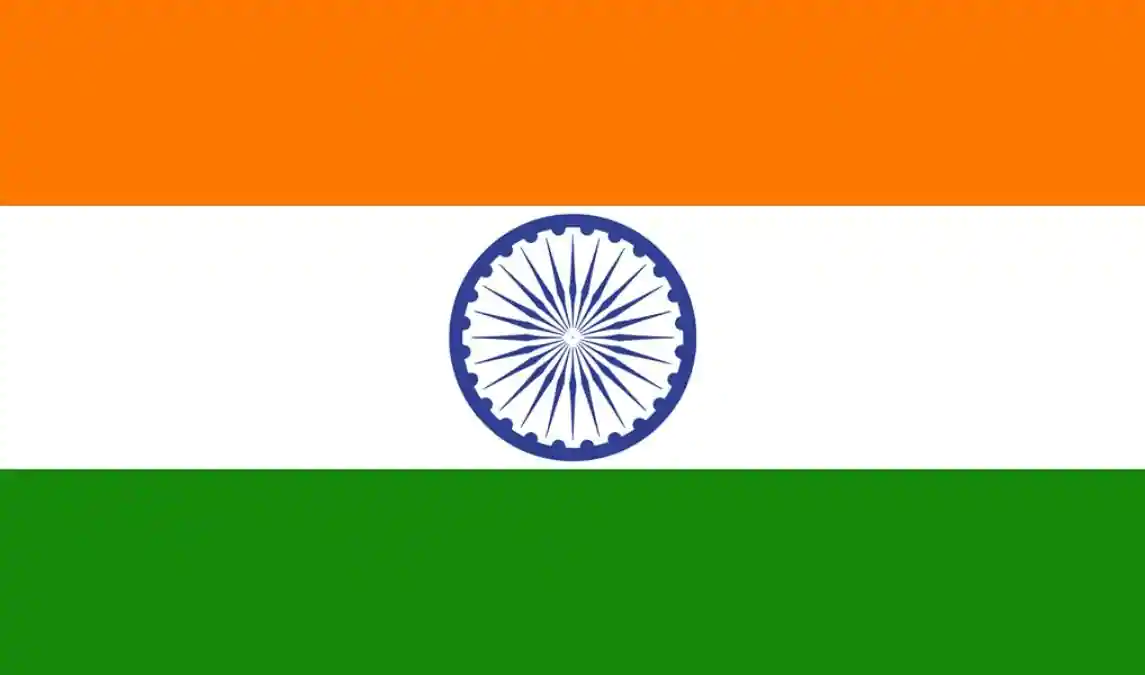
Present tricolour flag of India
On July 22, 1947, the Constituent Assembly adopted it as Free India National Flag. After the advent of Independence, the colours and their significance remained the same.
The top band of Saffron colour, indicated the strength and courage of the country. The white middle band indicated peace and truth with Dharma Chakra. The last band is green in colour showed the fertility, growth and auspiciousness of the land.
However, Dharma Charkha of Emperor Asoka was adopted in place of the spinning wheel as the emblem on the flag.
It depicted the "wheel of the law" in the Sarnath Lion Capital made by the 3rd-century BC Mauryan Emperor Ashoka. The chakra intends to show that there is life in movement and death in stagnation.
Thus, the tricolour flag of the Congress Party eventually became the tricolour flag of Independent India.
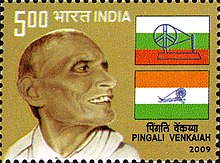

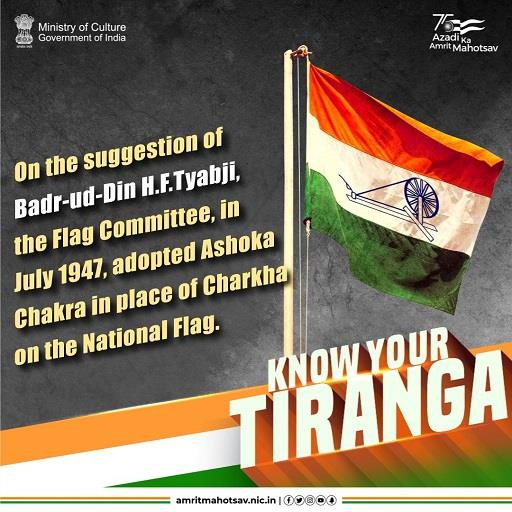
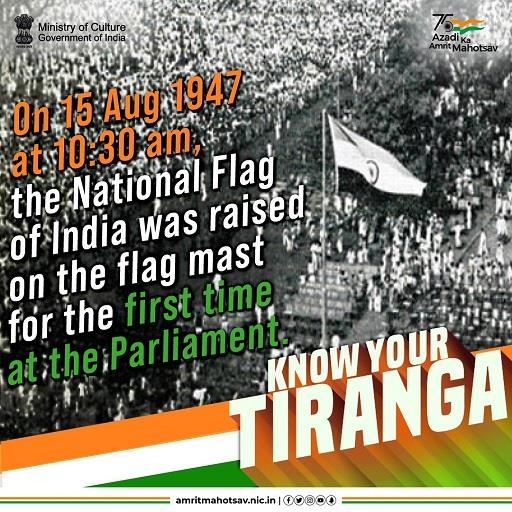
History Of Indian Tricolor
Every free nation of the world has its own flag. It is a symbol of a free country. The National Flag of India was adopted in its present form during the meeting of Constituent Assembly held on the 22 July 1947, a few days before India's independence from the British on 15 August, 1947. It served as the national flag of the Dominion of India between 15 August 1947 and 26 January 1950 and that of the Republic of India thereafter. In India, the term "tricolour" refers to the Indian national flag.
The National flag of India is a horizontal tricolor of deep saffron (kesari) at the top, white in the middle and dark green at the bottom in equal proportion. The ratio of width of the flag to its length is two to three. In the centre of the white band is a navy blue wheel which represents the chakra. Its design is that of the wheel which appears on the abacus of the Sarnath Lion Capital of Ashoka. Its diameter approximates to the width of the white band and it has 24 spokes.
Colours of the Flag
In the national flag of India the top band is of Saffron colour, indicating the strength and courage of the country. The white middle band indicates peace and truth with Dharma Chakra. The last band is green in colour shows the fertility, growth and auspiciousness of the land.
The Chakra
This Dharma Chakra depicted the "wheel of the law" in the Sarnath Lion Capital made by the 3rd-century BC Mauryan Emperor Ashoka. The chakra intends to show that there is life in movement and death in stagnation.
Every citizen of India gears up to celebrate the 75th Independence Day. This year, Modi government has launched a new campaign, ‘Har Ghar Tiranga’. Through this campaign, PM Modi has appealed to every citizen of India to participate in the campaign by displaying the National Flag in every home from August 13 to August 15. The Flag Code of India 2022 was amended by the government to make the National Flag accessible to all the Indians. The Flag Code of India was brought in effect on January 26, 2002. The Flag Code of India consists of set laws concerning the use, display, and hoisting of the Indian national flag. It also instructs how private; public and government institutions must display the national flag.
After the amendments, every citizen is now allowed to hoist the flag at home day and night. Though, there are still some rules that every citizen must follow to hoist the flag at their home. So, if you are planning to hoist the National Flag at home read the following some rules, dos and don’ts:
Earlier the national flag could only be hoisted between sunrise and sunset but now after the recent amendments made by the Government of India, the display of flag is allowed both during day and night, only if it is displayed in the open or on the house of a member of the public.
The National Flag should be displayed in proper manner, no damaged or untidy flag must never be displayed.
After the amendment on December 30, 2021, the Flag Code of India allowed the use of polyester or machine-made flags.
However, there is no particular size mentioned for the National Flag but the ratio should be followed as 3:2 and in rectangular in shape.
Flowers, wreath, emblems and other objects should not be placed on or above the flag mast.
During any circumstances, the National Flag should not touch the ground and trail in the water.
Our national flag-called Tiranga meaning tricolour was adopted on July 22, 1947 by the constituent assembly. It is made from khadi which is domestically spun Indian cotton as a symbol of nationalism and freedom. It has three equal horizontal bands. The top band consists is saffron which represents strength and courage. The middle part is white which denotes honesty, purity and peace of the nation. The bottom is green indicating the prosperity, fertility and growth.
The chakra contains 24 equally spaced spokes. According to the Hindu religion, 24 Rishis wielded the whole power of the Gayatri mantra containing 24 letters. All the 24 spokes of the Dharma chakra are the representation of the 24 rishis of the Himalayas in which Vishvamitra is first and Yajnavalkya the last. The Ashoka chakra is also known as Samay chakra in which the 24 spokes represent 24 hours of the day and is the symbol of the movement of the time. The Ashoka Chakra is rendered in navy blue on a white background replacing the symbol of the charkha of the pre-independence version of the flag. The chakra signifies that there is life in movement and death in stagnation. It represents the dynamism of a peaceful change. India should not resist the change. It must move and go forward.
Know Your National Flag
- What is the difference between a flag and National-flag?
Ans. A flag is a piece of cloth attached to a flagpole, representing a clan, community, army, office of authority, industrial house or an individual. In modern times a flag is commonly rectangular varying is size, colour and the design on it. On the contrary, a National-flag is more than a piece of cloth. It is the most solemn and constitutionally or traditionally authorized symbol of a country. It represents the whole country, the entire nation, its ideals, hopes, aspirations and the pride. People throughout the history of mankind have laid down life for their National-flag, as it is the strongest patriotic symbol.
- What is the nickname of our National-flag?
Ans. We fondly call our flag Tiranga, meaning having three colours. The nickname, however, is a misnomer because the flag in fact has four colours not three as is commonly understood. The forth colour blue of the Chakra is often not mentioned being a secondary colour in the flag.
- When was the National-flag for Independent India adopted?
Ans. After the British government declared to free India on the 15th of August 1947, Indian leaders realized the need to have a National-flag for Independent India. Accordingly, an ad-hoc Flag Committee was formed to finalize the Flag. On its recommendation the Constituent Assembly on 22nd July 1947 adopted the Tiranga as the National-flag for free-India.
- Name the person, whose design of the National-flag for free-India was finally accepted by the Constituent Assembly in 1947.
Ans. The design of the National-flag for Independent India submitted by Mrs. Suriaya Badr-ud-Din Tyabi was finally approved and accepted by the Flag Committee on 17th July 1947. She was an artist of repute and her husband B.H.F.Tyabji (ICS) was then a Deputy Secretary in the Secretariat of the Constituent Assembly.
- After India became an independent State, where did the first outdoor official flag hoisting take place in the world on the 15th of August, 1947?
Ans. The first outdoor official flag hoisting of Tiranga on the 15th of August 1947, took place inCanberra, Australia at the residence of Sir Raghunath Paranype, the High Commission of India in Australia at 1200 hrs local time and at 0730hrs IST which means three hours in advance of the first flag hoisting in India that took place at 10:30AM on the day at the present day Parliament House.
- The National Anthem of India “Jana-Gana- Mana” was adopted on the 24th of January, 1950 then which anthem was played / sung at the UN Headquarters in Washington on the 15th of August, 1947, when the Tiranga was first hoisted there amidst the flags of other free nations of the world?
Ans. Netaji Subhash Chandra Bose’s version of “Jana-Gana-Mana” was played at the UN HQ’s as the National Anthem of India. Netaji had recorded the song as his army’s anthem while he was in Germany. The UN HQ’s had a disc of the song available with them and the same was played by the UN orchestra while hoisting the Tiranga. Interestingly, Jana-Gana-Mana by then had not being adopted as the National Anthem of India.
- On the midnight of the 14-15 August, 1947 after the official declaration of India’s Independence in the Central Hall of the Council House (now known as Parliament House) a lady leading a group of 72 womenhad presented the first Tiranga to Dr. Rajendra Prasad, the Chariman of the Constitutent Assembly. Name the lady.
Ans. She was Mrs. Hansa Mehta from Gujarat, an educationist, orator and a freedom fighter who was i m - p r i s o n e d several times by the British India Government. She was known in her circle as a dictator. Mrs. Mehta died at the age of 98 in Bombay in 1995.
- Who said in the Council House on the midnight of the 14th-15th of August, 1947, “It is in the fitness of things that the first flag of free-India that is to fly over this August House should be a gift from the women of India”?
Ans. It was Mrs.Hansa Mehta who made this emotional statement, while presenting the first Tiranga to Dr.Rajendra Prasad, the then chairman of the Constituent Assembly.
- Where did the first flag hoisting take place in India after the first Indian government took the oath of office on the 15th of August 1947?
Ans: At the Council House (now known as Parliament House) at 10:30am. The Union Jack there was lowered for the last time personally by Lord Louis Mountbatten, the first Governor General of India, giving way to the Tiranga, which was raised for the first time on the flagmast by Pandit Jawaharlal Nehru.
- When was Tiranga unfurled for the first time on the ramparts of the Red Fort after Independence?
Ans. On the 16th of August 1947, which was a Saturday, at 8.30 A.M. On the 15th of August as both, theJawahar Lal Nehru, the first Prime-Minister of India were pre-occupied with many other inevitable official formalities, the flag hoisting at Red Fort was planned and executed on the next day i.e.,16th August 1947.
- Where was Tiranga first publically hoisted in New Delhi on the 15th of August, 1947?
Ans. The first public flag hoisting took place at the Princess Park near India Gate, New Delhi in the afternoon of 15th of August 1947. Pandit Jawahar Lal Nehru did the honour of hoisting the Tiranga. Mysteriously, as the Tiranga was unfurled a rainbow appeared on the skyline. The rareoccurrence amazed many including, Lord Louis Mountbatten whose carriage could not reach up to the dias due to the exuberant and unmanageable crowd that came to witness the ceremony.
- How many colours are there in our National flag?
Ans. There are four colours in our Flag; the saffron, white and the green as principal colours, and the navy blue of the Ashok Chakra is the secondary colour.
- What are the official names of the Saffron and Green, the two principal colours used in our National-flag?
Ans. The official name for saffron is “India-Saffron” and for green it is “India-Green”. While describing the colours of our flag to any international organization, the two colours are to be described and specified as explained because the two colours have many shades. Hence, we specify the two colours as India-Saffron and India-Green.
- What is the significance of the Saffron colour in our Flag?
Ans. The Saffron stands for courage, sacrifice, valour and the spirit of renunciation. It points to both wisdom and action. The colour also represents the scorched condition of the earth caused by the torrid heat of the Indian sun. It is the colour of spiritual life lead by sadhus, saints, pirs, fakirs and pundits.
- What is the significance of the White colour in our Flag ?
Ans. The White in Tiranga stands for purity. It is symbolic of the sun’s rays and thus denotes the path of light. It is also for peace and tranquility. The White of the Flag as well represents every religion and every language in the country.
- What is the significance of the Green colour in our Flag?
Ans. The Green is for growth and also denotes our relation with earth. Hence, it is the colour of vegetation, agriculture and plant life on which all other life depends. The Green also stands for hope and largely we live on hope.
- What is the significance of the Blue colour in our Flag?
Ans. The Blue in our flag signifies the boundless sky above and the fathomless sea below. The Blue also implies inner energy. The Chakra with its 24 spokes suggests continual progress of the country.
- What is the significance of the Ashok Chakra as shown in our Flag?
Ans. The wheel has been used since ancient times in India as a solar symbol. In July 1947, the Flag Committee chose the Ashoka’s Dharma Chakra for the reason that amongst all the chakras that came to their mind the “Sarnath Chakra” was the most beautiful and artistic. On the flag, it signifies India’s continual progress and growth.
- How many spokes are there in the Ashok Chakra on the centre band of the Flag?
Ans. There are 24 equally spaced spokes in the Chakra, signifying the 24 hours of the day.
- In which colour is the Ashok Chakra printed or embroidered on the Flag?
Ans. The Ashok Chakra in the centre on the white band of our flag is in navy blue.
- Which colours are mixed to form the Saffron in our Flag?
Ans. Red and yellow colours are mixed in a particular ratio to form the Saffron shade of our flag. Philosophically, the red denotes both valour and action whereas the yellow stands for wisdom.
- Who suggested, the Ashok Chakra in lieu of the Charkha, to the Flag Committee, while adopting the Tiranga in July, 1947?
Ans. The Ashok Chakra in place of the Charkha, which was in use earlier during our struggle for freedom, on the flag for Free-India was suggested to the Flag-Committee by Mr. Badr-ud-Din H.F.Tyabji, a Deputy Secretariat in the Constituent Assembly and the grandson of the great Tyabiji who was once the President of the Indian National Congress. Dr. Rajendra Prasad, the chairman of the Committee advised him to consult Gandhiji on the proposal to replace the Charkha with Know Your National Flag 23 Chakra. Gandhiji wanted to see for himself the look of the change before consenting. Mr. Tyabji’s wife prepared a sample by painting the Chakra on the white band of a sample flag. Gandhiji was happy with the proposed change and the Flag- Committee adopted the Chakra on the flag in place of Charkha.
- If the length of our National-flag is 18 feet, what will be its width?
Ans. It will be 12 feet.
- What is the ratio of the length to the width of our National-flag?
Ans. The ratio of the width to the length of the Flag shall ordinarily be two breadths to three breadths. In other words, the ratio is 2 : 3.
- Which type of fabric can be used for manufacturing the Tiranga to be used by general public?
Ans. Flags meant to be used by general public can be made of any fabric, preferably with hand-spun cotton or silk Khadi. Earlier it was mandatory to be of only Khadi.
- What type of fabric is to be used for manufacturing Tirangas meant for government offices, its agencies and government officials?
Ans. The flags meant to be used on government buildings are to be mandatorily made only of hand-spun cotton or silk Khadi. Even the stitching thread has to be Khadi for such flags.
- How many standard sizes of our National-flag are there as per the Bureau of Indian Standards (BIS) and the Flag Code of India?
Ans. As per the Flag Code of India and the Indian Bureau of Standards there are nine standard sizes of our National-flag. Earlier, they were only five which were later increased to severn. Flags of larger dimension can be made keeping the ration of 3:2.
THE NINE STANDARD SIZES OF THE FLAG
- Name the official book / booklet that lays down the Code for the use of our National-flag?
Ans. It is the ‘Flag Code of India’.
- Can you fly your National-flag at your home or at your work place on all the 365 days of the year?
Ans. Yes. In 2002, the Government of India had allowed citizens to fly the National-flag on all days, but by then it was not a Fundamental Right.
- Between what time to what time is the National-flag normally flown during day time?
Ans. The Flag is normally flown between sunrise and sunset.
- On what occasions do we fly the National-flag at half-mast?
Ans. In the event of death of certain dignitaries recognized by the centre/state governments, the National-flag shall be half-mast at certain places and for specified days.
- Name a few VVIP’S who can fly the Nationalflag on their car?
Ans. The President and Prime-Minister of India, Judges of the Supreme Court, Indian Ambassadors appointed in foreign lands, etc. can fly the National-flag on their car.
- Can you fly a miniature National-flag inside your car?
Ans. Yes, Indian citizens can fly the National-flag inside their car on the dash board or on the wind screen.
- Can you write a patriotic slogan or a message on the face of our National-flag?
Ans. No, lettering of any kind is not to be put upon the Flag.
- Can you print, stitch, embroider Tiranga as a part of your dress or costume? If yes, is there any restriction?
Ans. Yes, you can do so, but not below the waistline.
- Can you embroider or print the image of Tiranga on cushions, handkerchiefs, napkins or undergarments, etc?
Ans. No, it is not allowed nor it is desirable.
- How is an old, unclean, multilated or torn National-flag disposed off ?
Ans. It is destroyed in whole in private preferably by burning or by any other method consistent with the dignity of the Flag such as burying it deep with respect or by immersing it into the Ganga duly folded.
- While using the Tiranga on a dead body, how is the Flag placed on the body—horizontally or vertically?
Ans. It is placed horizontally on the chest of the deceased. The saffron band is to touch the neck of the body. The flag must not be placed over the body or coffin like a Chadar to avoid touching the feet of the deceased.
- How is the Flag placed on the dead body of a person disposed off?
Ans. The flag placed on a dead body is destroyed in private, away from public gaze preferably by burning or burying it deep or immersing it into the Gange.
- Can a Judge of a High Court fly the Nationalflag on his/her car?
Ans. Yes, the High Court judges can now fly the Nationalflag on their car. Earlier, they were not allowed to do so.
- Can the National-flag be flown during night? if yes, what are the restrictions?
Ans. The Flag can be flown during night hours provided, it is on a 100ft or above flagpole and is adequately illuminated.
- On a day when it is raining heavily do you have to lower the National-flag?
Ans. No, the Flag is to fly between sunrise and sunset regardless of weather conditions.
- When the Tiranga is to be flown with the National-flag of another country which side will the Tiranga be placed or flown — to the right or to the left?
Ans. While flying Tiranga besides another country’s National-flag, it will be placed / flown to the left as one looks at it.
- In case of death of a VVIP on 25th January or 14th August, or 1st October and a 7 day state mouring is declared, will the Flag fly half-mast the next day on 26th of January, 15th August, or 2nd October as the case may be?
Ans. No, in a such a case, the Flag will fly full-mast on 26th January, the Republic Day similarly on 15th August, the Independence Day and on the Gandhi Jayanti Day.
- In case of death of a VVIP on Republic Day 26th of January or on Independence day 15th of August or on 2nd of October and a state mourning is declared by the Government, will the Flag fly halfmast on the day?
Ans. No, it will fly full-mast, except on the building where the dead body lies in State. And as the body is removed from there for cremation, the flag will be raised fullmast on the building.
46 . When state mourning is declared by the Government on the death of a VVIP are the members of public suppose to fly the Flag at halfmast?
Ans. No, the general public is not suppose to half-mast the flag; however, they may do so at their discretion. It is so because the Flag is to be half-masted only on Govt. buildings on receiving instructions from the Government. Since no instructions are issued to public to half mast the flag, members of public are not obliged to do so.
- As per convention all jail buildings are suppose to fly the National-flag. After an execution of a prisoner in a particular jail, how will the Flag fly—half-mast or full-mast on the day?
Ans. The flag will fly full-mast on the jail building after execution of a prisoner . However, earlier it used to fly half-mast. In the Navy, if there is a death on board a ship while on the high sea her ensign is half-masted.
- When a foreign dignitary travels in a car provided by the Government of India or by a State Govern-ment, on which side of the car will the Indian National-flag be flown ?
Ans. On the right side of the car and on the left side, the National-flag of the dignitry’s country will be flown.
- When our National-flag is flown with the United Nation's Flag, on which side of it will the Tiranga fly?
Ans. When the Tiranga is flown besides the UN Flag, it can be flown on either side of it.
The National Flag of India was designed by Pingali Venkayya. He was an Indian freedom fighter from Andhra Pradesh.
According to the law, the National Flag of India is to be made by ‘Khadi’ which is hand-spun wool/cotton/silk Khadi cloth. Karnataka Khadi Gramodyoga Samyukta Sangha is the only unit in India that is accredited to supply and manufacture the Flag of India.
The Khadi Development and Village Industries Commission, have the manufacturing right to make the National Flag of India.
The National Flag is known as Tiranga in Hindi and it consists of three colors and Asoka Chakra in its middle. Three colors represent:
The Saffron color -Courage and sacrifice
White – Truth, peace, and purity
The Green colour-Prosperity
Asoka Chakra represents the Laws of Dharma
The Asoka Chakra was selected as a depiction of Dharma. The size of the Asoka Chakra was not defined in the Flag code. The Asoka Chakra should have 24 spokes that are uniformly spaced. The Asoka Chakra is in a Navy-blue colour on the white strip of the flag.
The width to length ratio of the National Flag of India is 2:3. The three strips of the flag should be equivalent in width and length.
The Indian flag was accepted on July 22, 1947, just before India gained independence from the British Empire.
On May 29, 1953, Edmund Hillary and Sherpa Tenzing Norgay conquered the Mount Everest and raised the Indian flag on Mount Everest, along with the National Flag of the United Kingdom of Great Britain and Northern Ireland and the Nepalese National Flag.
The largest Indian flag was hoisted in Indo-Pak Attari Border. Nation’s largest flag measures 110 meters in length, 24 meters in width and 55 tons in weight.
During the Indo-Soviet joint space flight in April 1984, the National Flag of India flew into space as an emblem on the spacesuit worn by Cosmonaut Wing Commander Rakesh Sharma.


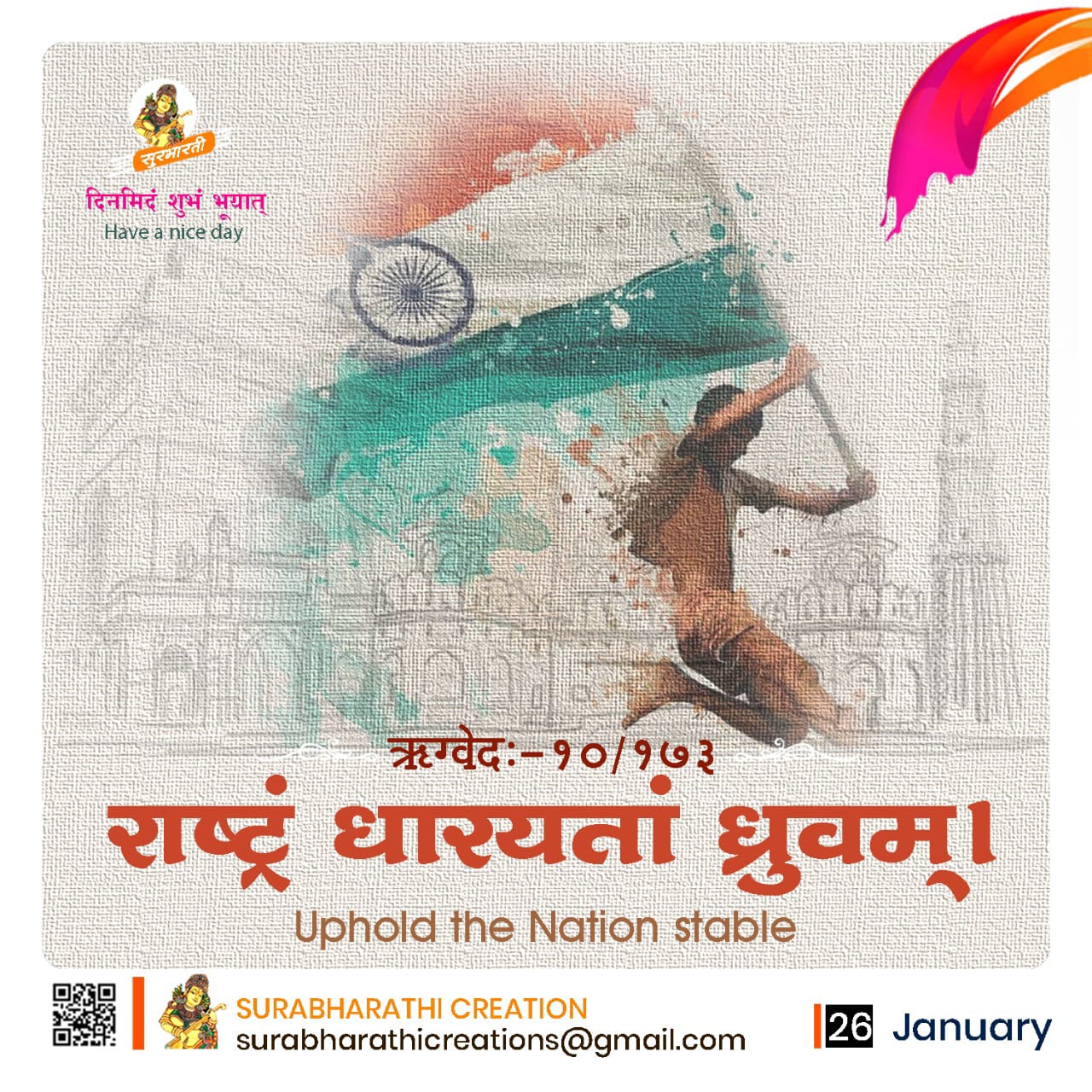
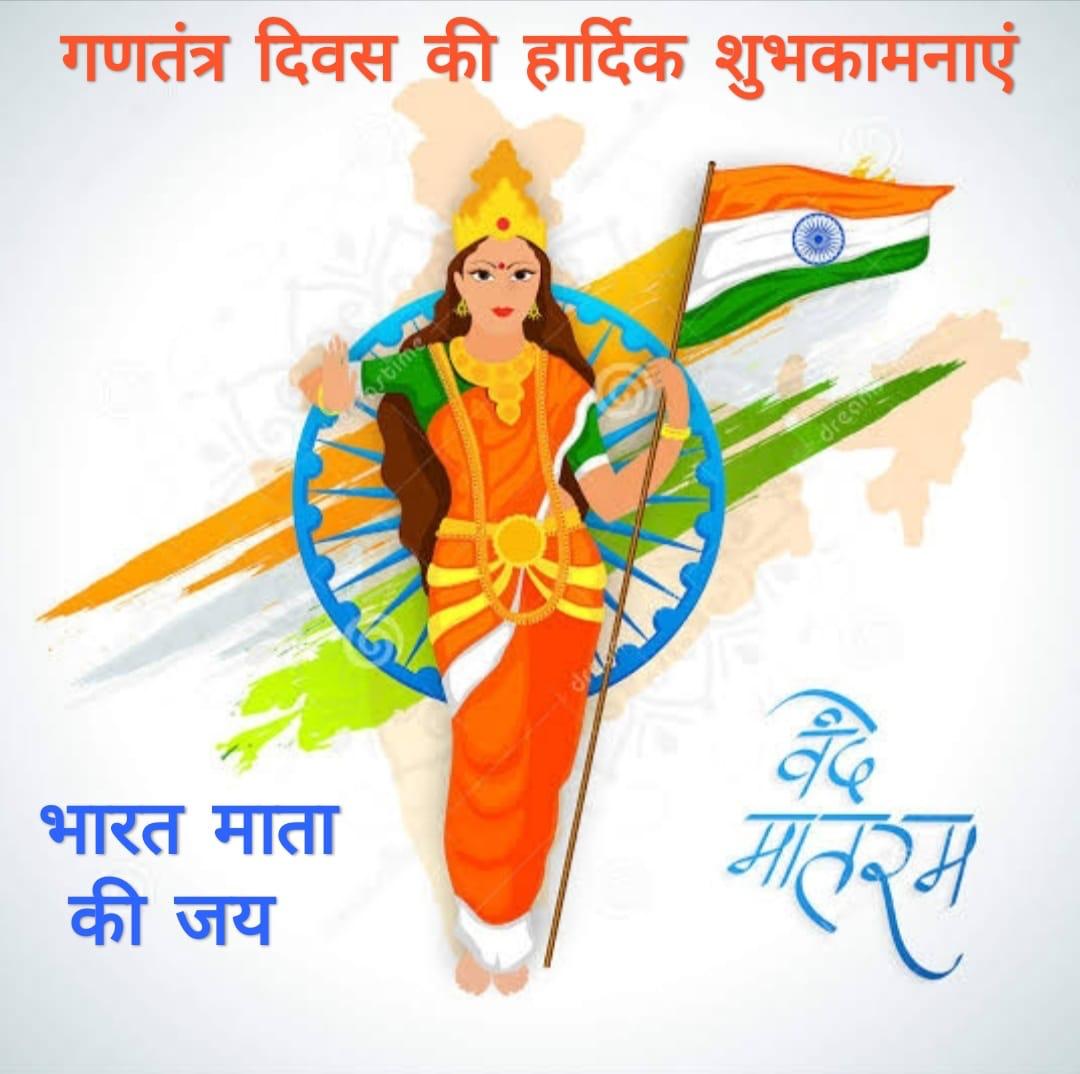
Narey:
Tum Mujhe khoon do, Mai tumhe aajadi doonga
Hothon pe ganga ho, Hathon me tiranga ho
Jai jawan Jai kisan
Doodh maango to kheer denge, Kashmir maango to cheer denge
वह खून खून नही वह पानी है, जो देश के काम ना आये बेकार वो जवानी है
Inklaab Jindabad
Vande Matram
Bharat Mata ki Jai
Aneekta mai ekta, Hinduon ki vishesta
Flag Code
On 26th January 2002, the Indian flag code was modified and after several years of independence, the citizens of India were finally allowed to hoist the Indian flag over their homes, offices and factories on any day and not just National days as was the case earlier. Now Indians can proudly display the national flag any where and any time, as long as the provisions of the Flag Code are strictly followed to avoid any disrespect to the tricolour. For the sake of convenience, Flag Code of India, 2002, has been divided into three parts. Part I of the Code contains general description of the National Flag. Part II of the Code is devoted to the display of the National Flag by members of public, private organizations, educational institutions, etc. Part III of the Code relates to display of the National Flag by Central and State governments and their organisations and agencies.
There are some rules and regulations upon how to fly the flag, based on the 26 January 2002 legislation. These include the following:
The Do's: The National Flag may be hoisted in educational institutions (schools, colleges, sports camps, scout camps, etc.) to inspire respect for the Flag. An oath of allegiance has been included in the flag hoisting in schools. A member of public, a private organization or an educational institution may hoist/display the National Flag on all days and occasions, ceremonial or otherwise consistent with the dignity and honour of the National Flag. Section 2 of the new code accepts the right of all private citizens to fly the flag on their premises. The Don'ts: The flag cannot be used for communal gains, drapery, or clothes. As far as possible, it should be flown from sunrise to sunset, irrespective of the weather. The flag cannot be intentionally allowed to touch the ground or the floor or trail in water. It cannot be draped over the hood, top, and sides or back of vehicles, trains, boats or aircraft. No other flag or bunting can be placed higher than the flag. Also, no object, including flowers or garlands or emblems can be placed on or above the flag. The tricolour cannot be used as a festoon, rosette or bunting.

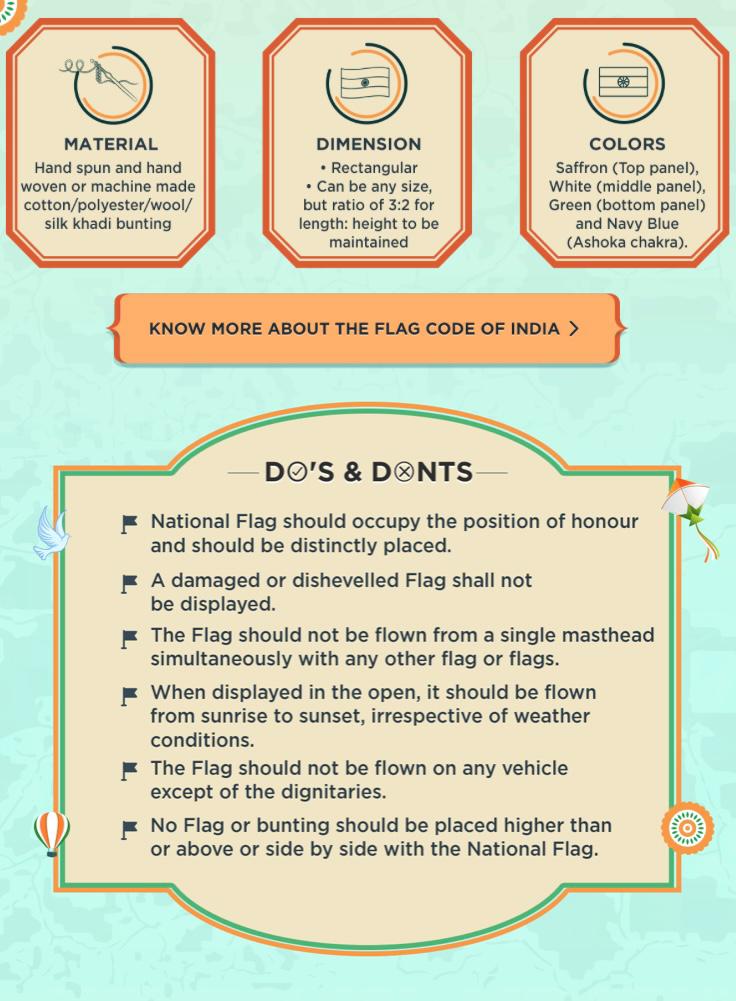
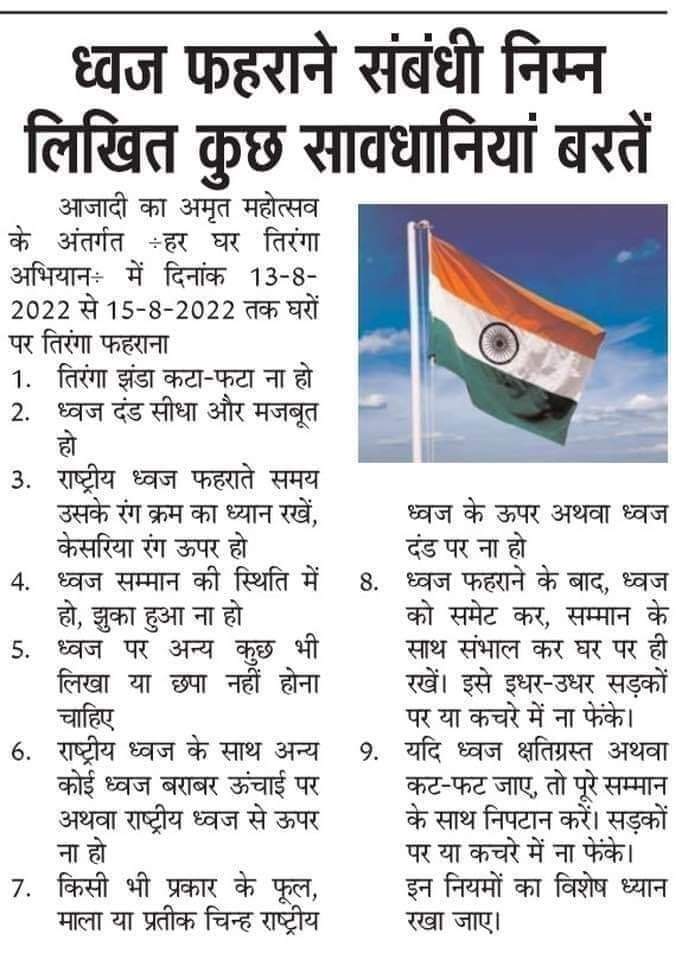
Prevention_Insults_National_Honour_Act1971_1.pdf
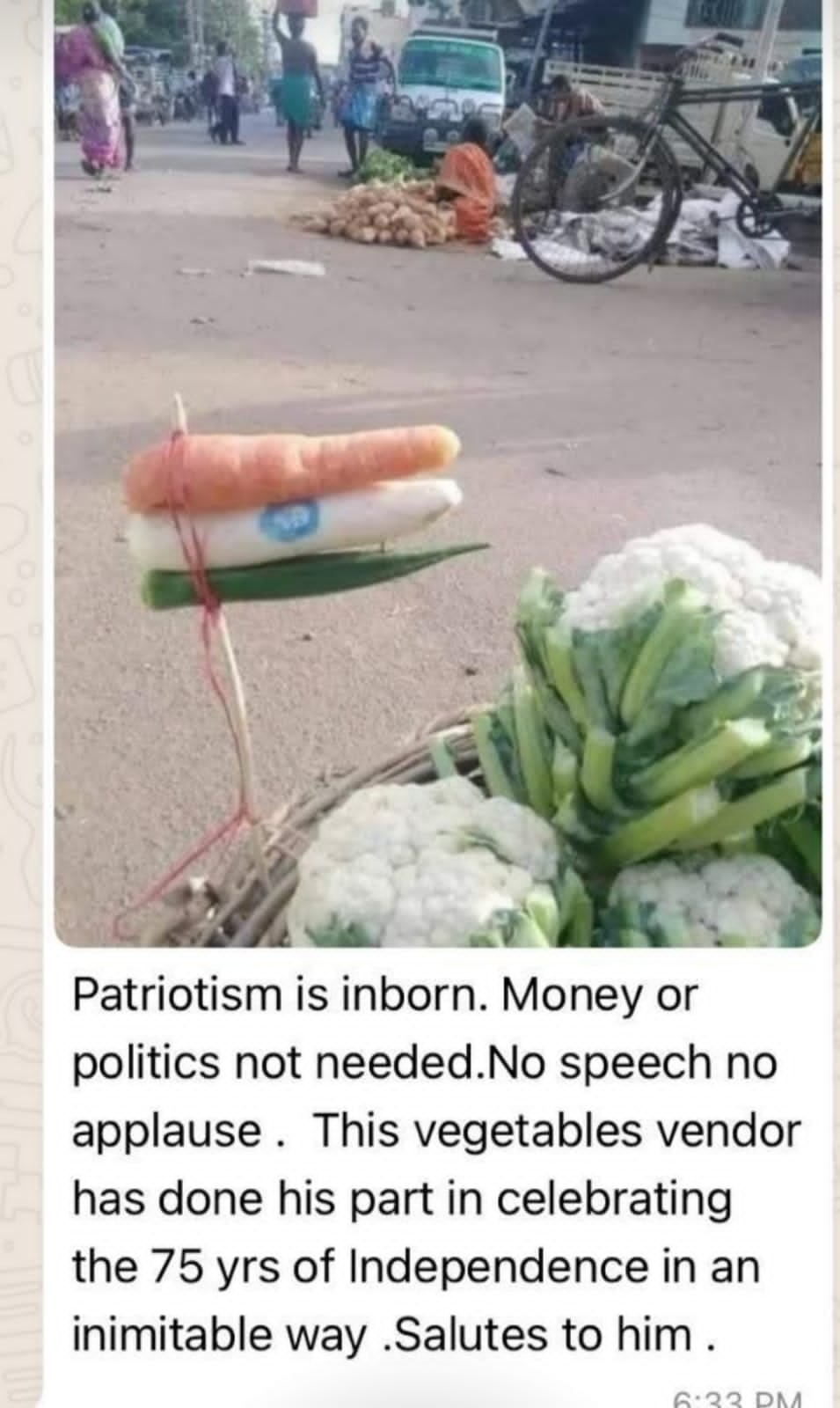
‘Har Ghar Tiranga’ is a campaign under the aegis of Azadi Ka Amrit Mahotsav to encourage people to bring the Tiranga home and to hoist it to mark the 75th year of India’s independence. Our relationship with the flag has always been more formal and institutional than personal. Bringing the flag home collectively as a nation in the 75th year of independence thus becomes symbolic of not only an act of personal connection to the Tiranga but also an embodiment of our commitment to nation-building. The idea behind the initiative is to invoke the feeling of patriotism in the hearts of the people and to promote awareness about the Indian National Flag.
To mark this momentous occasion, you are encouraged to hoist the flag in your homes from 13th to 15th August 2022.
Apart from this, you can also ‘Pin a Flag’ virtually at https://harghartiranga.com, along with posting a ‘Selfie with Flag’ on the site.
Frequently Asked Questions (FAQs) about the Indian National Flag
Q1. Is the use, display and hoisting of the National Flag guided by any overarching set of instructions?
Yes – the ‘Flag Code of India 2002’ and the Prevention of Insults to National Honour Act, 1971.
Q2. What is the Flag Code of India?
The Flag Code of India brings together all laws, conventions, practices, and instructions for the display of the National Flag. It governs the display of the National Flag by Private, Public, and Government Institutions. The Flag Code of India took effect on 26th January 2002.
Q3. Which material can be used to produce the National Flag?
The Flag Code of India, 2002 was amended vide Order dated 30th December, 2021 and National Flag made of polyester or machine made Flag have been allowed. Now, the National Flag shall be made of handspun and handwoven or machine-made, cotton/polyester/wool/silk/khadi bunting.
Q4. What is the appropriate size and ratio of the National Flag?
As per paragraph 1.3 & 1.4 of the Flag Code of India, the National Flag shall be rectangular in shape. The Flag can be of any size but the ratio of the length to the height (width) of the National Flag shall be 3:2.
Q5. Can I display the National Flag at my home?
As per paragraph 2.2 of the Flag Code of India, a member of the public, a private organization, or an educational institution may hoist/display the National Flag on all days or occasions in accordance with the dignity and honour of the National Flag.
Q6. What is the timing for flying the National Flag in the open/at the home?
The Flag Code of India, 2002 was amended vide Order dated 20th July, 2022 and clause (xi) of paragraph 2.2 of Part-II of the Flag Code of India was replaced by the following clause:
“where the Flag is displayed in open or displayed on the house of a member of public, it may be flown day and night”
Q7. What should I keep in mind while displaying the National Flag at my home?
Whenever the National Flag is on display, it should occupy the position of honor and should be distinctly placed. A damaged or disheveled National Flag should not be displayed.
Q8. What should I keep in mind to avoid incorrect display of the National Flag?
The National Flag shall not be displayed in an inverted manner; i.e.; the saffron band should not be the bottom band
A damaged or disheveled National Flag shall not be displayed
The National Flag shall not be dipped in salute to any person or thing
No other flag or bunting shall be placed higher than or above or side by side with the National Flag; nor shall any object including flowers or garlands, or emblem be placed on or above the flagmast from which the National Flag is flown.
The National Flag shall not be used as a festoon, rosette, bunting, or in any other manner for decoration
The National Flag shall not be allowed to touch the ground or the floor or trail in the water
The National Flag shall not be displayed or fastened in any manner as may damage it
The National Flag should not be flown from a single masthead (top part of a flagpole) simultaneously with any other flag or flags
The National Flag shall not be used to cover a speaker's desk, nor shall it be draped over a speaker's platform
The National Flag shall not be used as a portion of costume or uniform or accessory of any description which is worn below the waist of any person nor shall it be embroidered or printed on cushions, handkerchiefs, napkins, undergarments or any dress material
Q9. Are there any rules for prevention of insult to the Indian National Flag?
Yes. In accordance with explanation 4 to section 2 of 'The Prevention of Insults to National Honour Act, 1971’, the following should be observed:
The National Flag shall not be used as a form of drapery in any form whatsoever, including private funerals
The National Flag shall not be used as a portion of costume or uniform or accessory of any description which is worn below the waist of any person nor shall it be embroidered or printed on cushions, handkerchiefs, napkins, undergarments or any dress material
There shall be no lettering upon the National Flag
The National Flag shall not be used to wrap, receive, or deliver things
The National Flag shall not be used to cover the sides, back, and top of any vehicle.
Q10. What is the correct way to display the National Flag in the open/on public buildings?
When the National Flag is displayed flat and horizontal on a wall, the saffron band shall be upper most and when displayed vertically, the saffron band shall be to the right in reference to the National Flag i.e., it should be to the left of a person facing it.
When the National Flag is displayed from a staff projecting horizontally or at an angle from a sill, balcony, or front of a building, the saffron band shall be at the farther end of the staff.
Q11. Should the National Flag be flown at half-mast?
The National Flag shall not be flown at half-mast except on occasions instructed by the Government of India. When flown at half-mast, the National Flag shall be hoisted first to the peak/top of the staff, then lowered to the half-mast position. Before lowering the National Flag for the day, it should be raised again to its peak.
Q12. Can I display the National Flag on my car?
The privilege of hoisting the National Flag on motor cars is only limited to the following persons as per paragraph 3.44 of the Flag Code of India, 2002.
President
Vice-President
Governors and Lieutenant Governors
Heads of Indian Missions/Posts
Prime Minister
Cabinet Ministers, Minister of State, and Deputy Ministers of the Union
Chief Minister and Cabinet Minister of a State or Union Territory
Speaker of the Lok Sabha, Deputy Chairman of Rajya Sabha, Deputy Speaker of Lok Sabha, Chairman of Legislative Councils in States, Speakers of the Legislative Assemblies in States and Union Territories, Deputy Chairman of Legislative Council in States, Deputy Speakers of Legislative Assemblies in States and Union Territories
Chief Justice of India
Judges of Supreme Court
Chief Justice of High Courts
Judges of High Courts
Q13. How can we display the Indian National Flag along with flags of other nations?
As per paragraph 3.32 of the Flag Code of India, when the National Flag is displayed in a straight line with flags of other countries, the National Flag shall be on the extreme right. The flags of other nations will follow in an alphabetical order as per the English versions of names of the nations.
If the flags are flown in a closed circle formation, the National Flag is flown first and is followed by flags of other national in a clockwise manner.
When the flag is displayed against the wall with another flag from crossed staffs, the National Flag shall be on the right and its staff will be in front of the staff of the other flag.
When the National Flag is flown with flags of other nations, the flag masts shall be of equal size.
Q14. How should the National Flag be disposed?
As per paragraph 2.2 of the Flag Code of India, if the National Flag is damaged, it shall be destroyed as a whole in private, preferably by burning or any other method considering the dignity of the National Flag.
The National Flag, if made of paper, is waved by the general public, these flags should not be discarded on the ground. These should be discarded in private, keeping in mind the dignity of the National Flag.
Salient Features of Flag Code of India, 2002
The Indian National Flag represents the hopes and aspirations of the people of India. It is the symbol of our national pride and there is universal affection and respect for, and loyalty to, the National Flag. It occupies a unique and special place in the emotions and psyche of the people of India.
The hoisting/use/display of the Indian National Flag is governed by the Prevention of Insults to National Honour Act, 1971 and the Flag Code of India, 2002. Some of salient features of the Flag Code of India, 2002 are listed below for the information of the public:-
The Flag Code of India, 2002 was amended vide Order dated 30st December, 2021 and National Flag made of polyester or machine made Flag have been allowed. Now, the National Flag shall be made of hand spun and hand woven or machine made, cotton/polyester/wool/silk khadi bunting.
A member of public, a private organization or an educational institution may hoist/display the National Flag on all days and occasions, ceremonial or otherwise, consistent with the dignity and honour of the National Flag.
The Flag Code of India, 2002 was amended vide Order dated 19th July, 2022 and clause (xi) of paragraph 2.2 of Part-II of the Flag Code of India was replaced by the following clause:-
(xi) “where the Flag is displayed in open or displayed on the house of a member of public, it may be flown day and night;”
The National Flag shall be rectangular in shape. The Flag can be of any size but the ratio of the length to the height (width) of the Flag shall be 3:2.
Whenever the National Flag is displayed, it should occupy the position of honour and should be distinctly placed.
A damaged or dishevelled Flag shall not be displayed.
The Flag should not be flown from a single masthead simultaneously with any other flag or flags.
The Flag should not be flown on any vehicle except of the dignitaries mentioned in Section IX of Part III of the Flag Code, such as President, Vice-President, Prime-Minister, Governors etc.
No other flag or bunting should be placed higher than or above or side by side with the National Flag.
फ्लैग कोड 2002 को 30 दिसंबर 2021 में संशोधित कर राष्ट्रीय ध्वज को पॉलिएस्टर या मशीन से ध्वज बनाने की अनुमति दी गयी। अब राष्ट्रीय ध्वज को हाथ से या मशीन से सूती, पॉलिएस्टर, ऊन, रेशम या खादी के कपड़े द्वारा बनाया जा सकता है।
निजी, सार्वजनिक तथा सरकारी संस्थानों द्वारा राष्ट्रीय ध्वज के प्रदर्शन से संबंधित सभी कानून, परंपरा और निर्देश फ्लैग कोड के तहत आते हैं। यह फ्लैग कोड 26 जनवरी 2002 को लागू हुआ था।
KnowYourTiranga protocol: The National Flag must never be put on the ground. Our Flag is our pride & should always fly high! 🇮🇳 AmritMahotsav, HarGharTiranga, MainBharatHoon, IndiaAt75.
PrimeMinister hoists the NationalFlag on Independence Day, whereas the President unfurls it on the RepublicDay
Respect for our Tiranga shall be maintained at all times. Using it as a part of a costume, uniform, napkins, etc is in violation of The Prevention of Insults to National Honor Act, 1971.
फ्लैग कोड 2002 को 30 दिसंबर 2021 में संशोधित कर राष्ट्रीय ध्वज को पॉलिएस्टर या मशीन से ध्वज बनाने की अनुमति दी गयी। अब राष्ट्रीय ध्वज को हाथ से या मशीन से सूती, पॉलिएस्टर, ऊन, रेशम या खादी के कपड़े द्वारा बनाया जा सकता है।
निजी, सार्वजनिक तथा सरकारी संस्थानों द्वारा राष्ट्रीय ध्वज के प्रदर्शन से संबंधित सभी कानून, परंपरा और निर्देश फ्लैग कोड के तहत आते हैं। यह फ्लैग कोड 26 जनवरी 2002 को लागू हुआ था।
The National Flag must never be placed upside down. Our Flag is our pride & should always fly high!
The 1st Stamp of Independent India was issued on 21 Nov 1947 and depicted the Indian Flag with the patriots' slogan, 'Jai Hind'. It was valued at three & one-half annas
Taking India to the space! In the 1984 space flight, the Indian National Flag flew into space as an emblem on the spacesuit worn by Cosmonaut Wg Cdr #RakeshSharma.
The idea to use Ashoka Chakra instead of Chakra was suggested by Badr-ud-Din H.F. Tyabji. He was further advised by the committee to consult #Gandhiji to whom he showed a sample made by his wife. Gandhiji happily gave the nod to the new design & the committee immediately adopted it on the Flag
On 15th Aug 1947 at 10:30 am #India witnessed history in the making. It was the day the British flag was lowered by Louis Mountbatten, giving way to the Indian National Flag, which was raised for the first time on the flag mast at the Parliament.
in July 1947, the Flag Committee chose Ashoka’s Dharma Chakra as a symbol on the flag for the reason that amongst all the chakras that came to their mind the “Sarnath Chakra” was the most striking & artistic
श्याम जी कृष्ण वर्मा, मैडम भीकाजी कामा, तथा वीर सावरकर जी ने वर्ष 1907 में राष्ट्रीय ध्वज का नया संस्करण तैयार किया। जिसमें डिजाइन के साथ रंगों में भी बदलाव किया गया था।
वर्ष 1906 में डिज़ाइन किये गये राष्ट्रीय ध्वज में तीन रंगों को शामिल किया गया, जिसके बीच में 'वंदे मातरम्' लिखा था।
On reaching the top of the summit, Tenzing Norgay, one of the first 2 men to conquer Mt. Everest, unfurled India's National Flag. Thus becoming the first person to do so in 1953
Hon’ble Prime Minister calls for strengthening the “Har Ghar Tiranga” campaign
The initiative of Azadi Ka Amrit Mahotsav was launched by Hon’ble Prime Minister Narendra Modi on 12th March 2021 to celebrate and commemorate 75 glorious years of Independence of India. Since its launch, the initiative has successfully showcased the magnificence of Indian culture all across the globe. With over 50,000 events successfully held across 28 States, 8 UTs, and 150+ countries, the initiative of Azadi Ka Amrit Mahotsav is one of the largest programs ever organized in terms of scope and participation.
To further elevate the patriotic effect that Azadi Ka Amrit Mahotsav has had on the country, Hon’ble Prime Minister Narendra Modi launched “Har Ghar Tiranga” campaign today to encourage people to bring the Tiranga home and hoist it to mark the 75th year of India’s independence. The Indian National flag exhibits the hope and aspirations of the people of India and proves to be an important symbol of our national pride. The idea behind the initiative is to invoke the feeling of patriotism in the hearts of the people and to promote awareness about the Indian National Flag.
State, Union Territories, and Ministries are participating extensively in the campaign with full fervor. NGOs and Self-Help Groups from various places are already contributing toward making Har Ghar Tiranga an iconic benchmark in the success path of Azadi Ka Amrit Mahotsav. Places such as Kupwara in Jammu and Kashmir, and Mandala in Madhya Pradesh are proving themselves to be an iconic example of showcasing people’s participation or Jan Bhagidari in the Har Ghar Tiranga campaign.
This campaign aims to have flags hoisted across the country from 13th to 15th August 2022. Various events involving people from all walks of life will also be organized at various locations connected with Freedom Struggle, to portray the patriotism and unity of the entire country.
Government of India has taken various steps to ensure the supply of flags across India. All Post Offices in the country shall start selling flags from 1st August 2022. In addition, State Governments have also tied up with various stakeholders for the supply and sale of flags. The Indian National Flag has also been registered on the GeM portal. The Government has also tied up with various e-commerce websites and Self-Help Groups to streamline the process of the supply of flags.
Apart from physically hoisting the flag, there are also virtual ways to participate in this campaign. Ministry of Culture has launched a website https://harghartiranga.com/ where one can ‘Pin a Flag’ and also post a ‘Selfie with Flag’ to show one’s patriotism.
Narendra Modi
This year, when we are marking Azadi Ka Amrit Mahotsav, let us strengthen the Har Ghar Tiranga Movement. Hoist the Tricolour or display it in your homes between 13th and 15th August. This movement will deepen our connect with the national flag. https://harghartiranga.com
